Isfahan, Esfahan in Persian, is probably the most beautiful city in Iran and offers numerous breathtaking sights and things to do. To describe the incredible beauty of their hometown, locals like to use the Persian proverb “Isfahan nesf-e jahan”, which translates to “Isfahan is half the world”. The enchanting mosques and palaces with their detailed mosaic art, the impressive bridges and the beautiful Naqsh-e Jahan square with its life and hustle and bustle will cast a spell over you. Naqsh-e Jahan Square and the bridges of Isfahan are even among the most important sights in all of Iran.
But where is Isfahan actually located? The city is located 400 kilometers south of Tehran in the Isfahan province of the same name. In this blog post, I show you the 14 most beautiful sights and things to do in Isfahan.
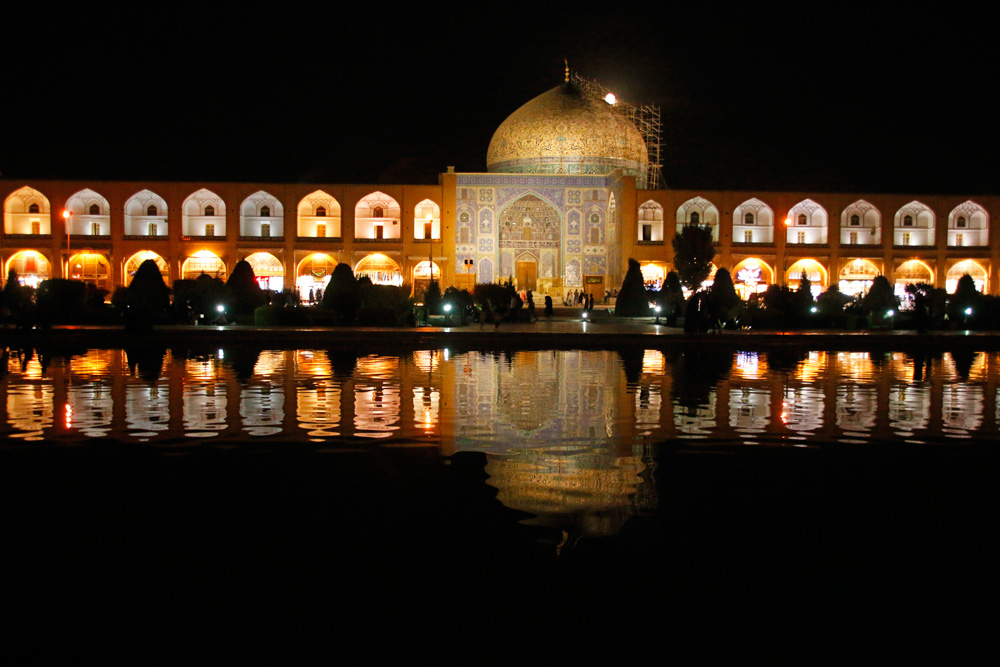
Naqsh-e Jahan Square
Naqsh-e Jahan Square, also known as Meydan-e Naqsh-e Jahan, formerly used to be called Meydan-e Imam and Meydan-e Shah. With nine hectares, it is the second largest square after Tiananmen Square in Beijing and one of the most beautiful squares in the world. It was built between 1598 and 1629 at the instigation of Shah Abbas I. It has been a UNESCO World Heritage Site since 1979. Naqsh-e Jahan means “half the world” and is a very appropriate name. On the east side of the square is the Sheikh Lotfollah Mosque, on the south side is the Shah Mosque and on the west side is the Ali Qapu Palace. In the center of the square is a large water basin with several fountains, which, like the buildings, are illuminated at night. Two-story arcades frame the square.
The best view of Naqsh-e-Jahan Square is from the Ali Qapu Palace veranda or from the gallery above the entrance to the Grand Bazaar on the north side of the square. You can explore it either on foot or in one of the horse-drawn carriages that await locals and visitors alike. The life and hustle and bustle as well as the atmosphere on the square are absolutely thrilling. Everywhere you will meet locals strolling across Naqsh-e Jahan Square, sitting on the lawns and having a picnic or cooling their feet in the pool. Their warmth and open-mindedness to visitors give you a fantastic insight into the unparalleled Iranian hospitality.
- Address: Naqsh-e Jahan Square, Isfahan, Iran.
- Opening hours: Around the clock.
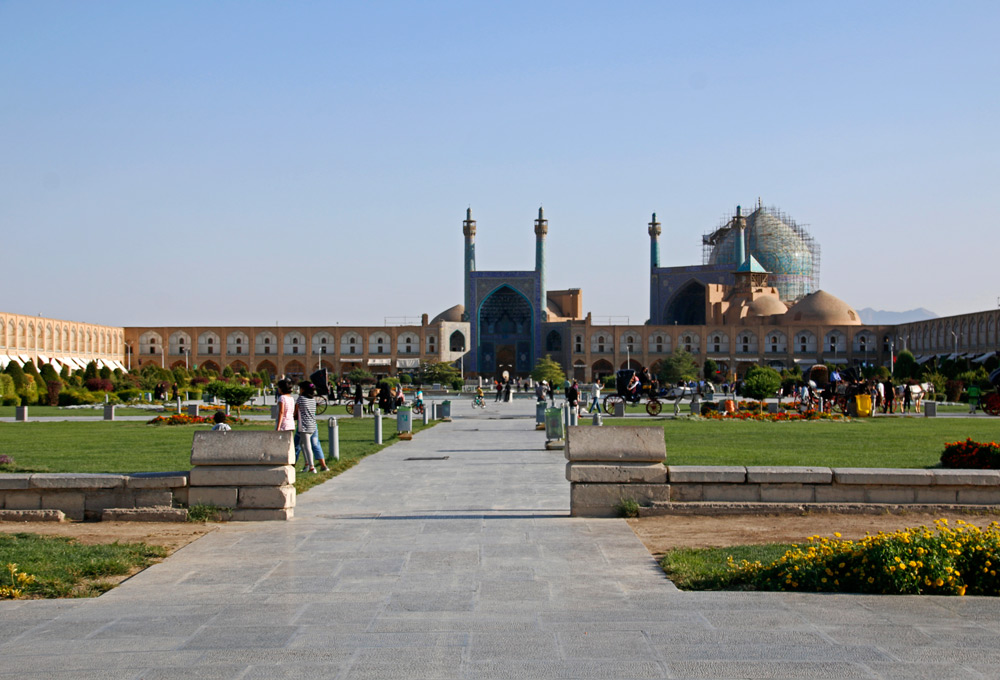
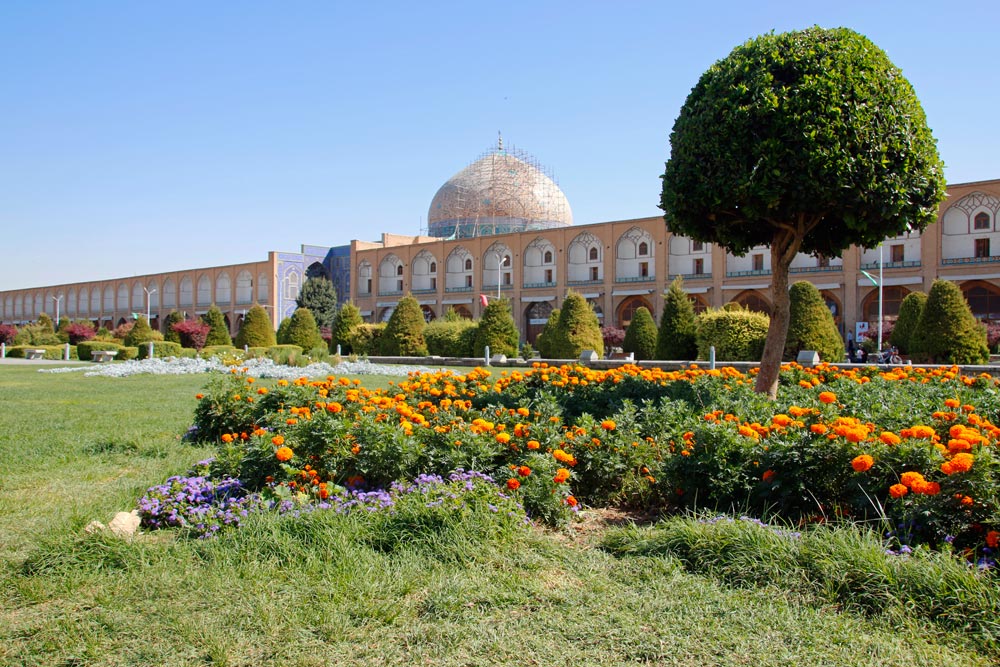

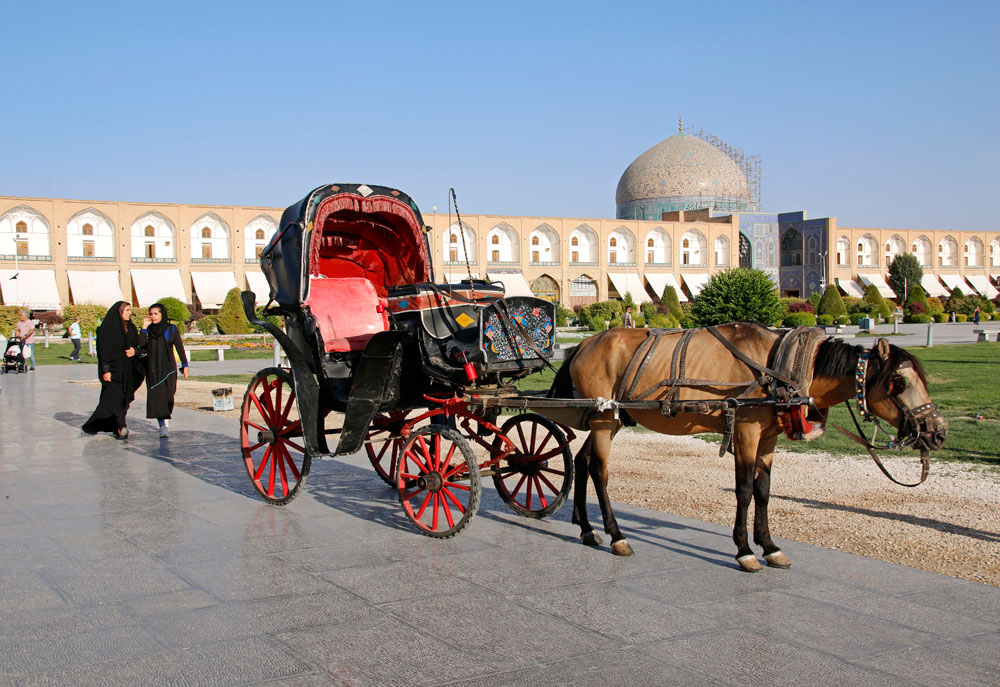

Sheikh Lotfollah Mosque
The impressive Sheikh Lotfollah Mosque is located on the east side of Naqsh-e Jahan Square and is one of the most beautiful mosques in Iran, if not in the world. Its colorful entrance portal in shades of blue and turquoise is decorated with calligraphy and stalactites. The imposing, sand-colored dome is 32 meters high and decorated with floral designs. The entire interior of the mosque is tiled with faience tiles and decorated with calligraphy. Through a winding corridor you reach the prayer hall facing Mecca. There you will see the majestic inner dome and the beautiful Islamic prayer niche known as the Mihrab. The colors and decorations are all the more accentuated by the incident light of the sixteen tambour windows.
The Sheikh Lotfollah Mosque was built between 1603 and 1619 at the behest of Shah Abbas I. He had it built by the architect Ali Reza Abbasi and gave it his father-in-law’s name in 1622. Unlike many mosques, the Sheikh Lotfolllah Mosque has neither a minaret nor an inner courtyard with washing facilities. This is probably because it served as a private mosque for the Shah and his family. It used to be called the women’s mosque, since the women of the royal family could access the Ali Qapu Palace opposite, protected from prying eyes, through an underground passage. However, this corridor was later closed.
- Address: East side of Naqsh-e Jahan Square, Isfahan, Iran.
- Opening Hours: Monday to Sunday from 9.00 AM to 12.30 PM and from 2.00 PM to 6.00 PM.
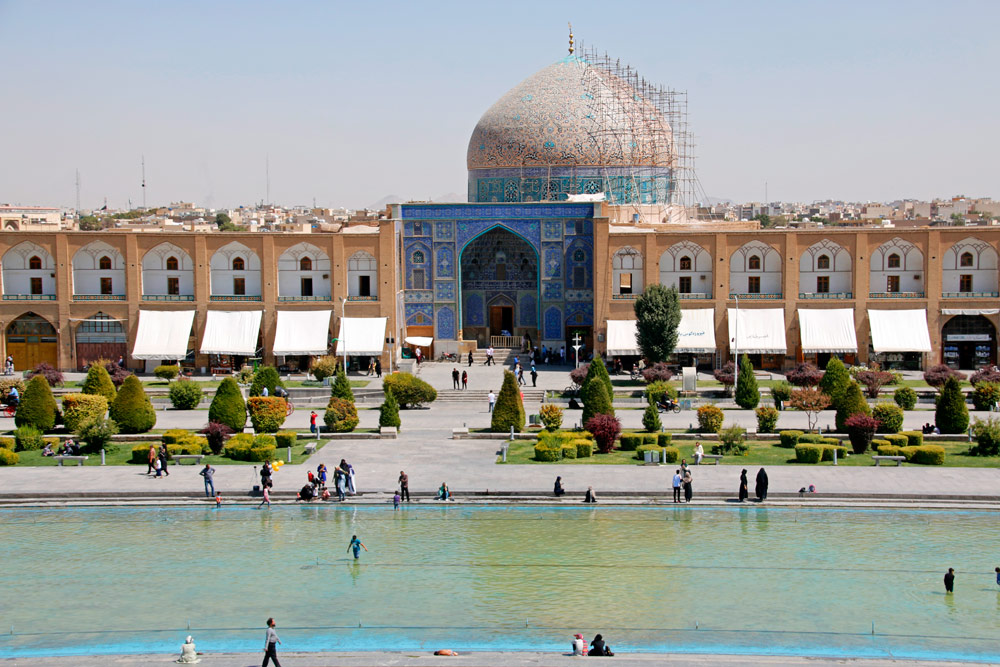

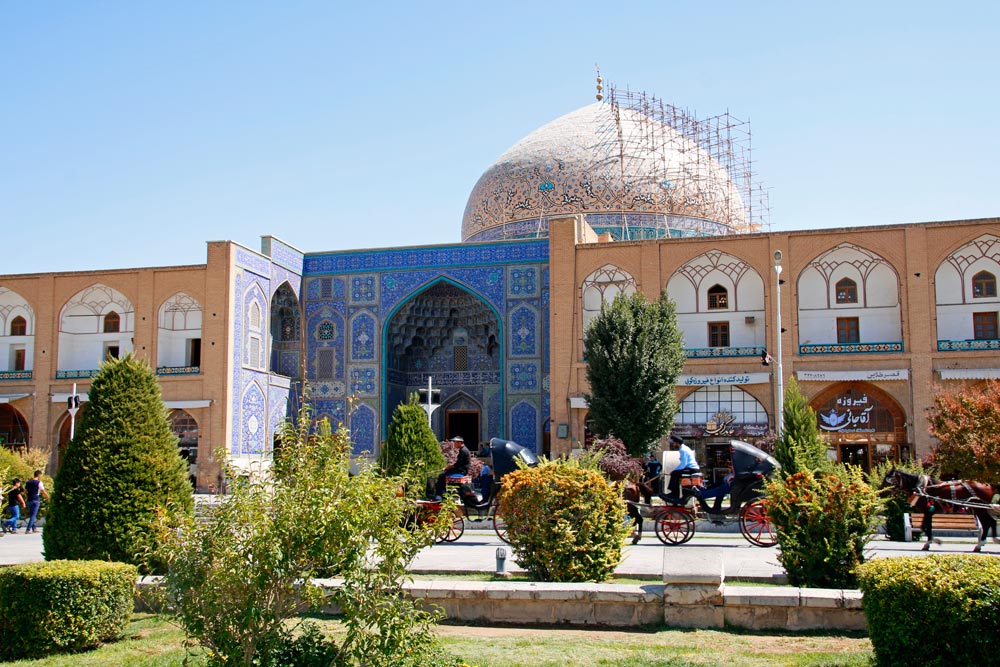
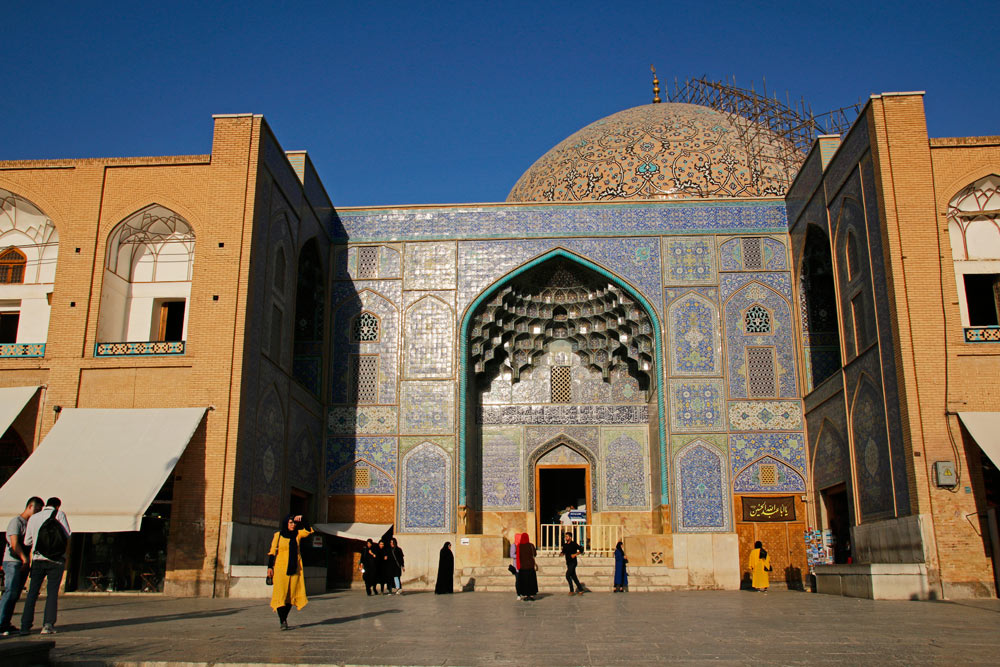
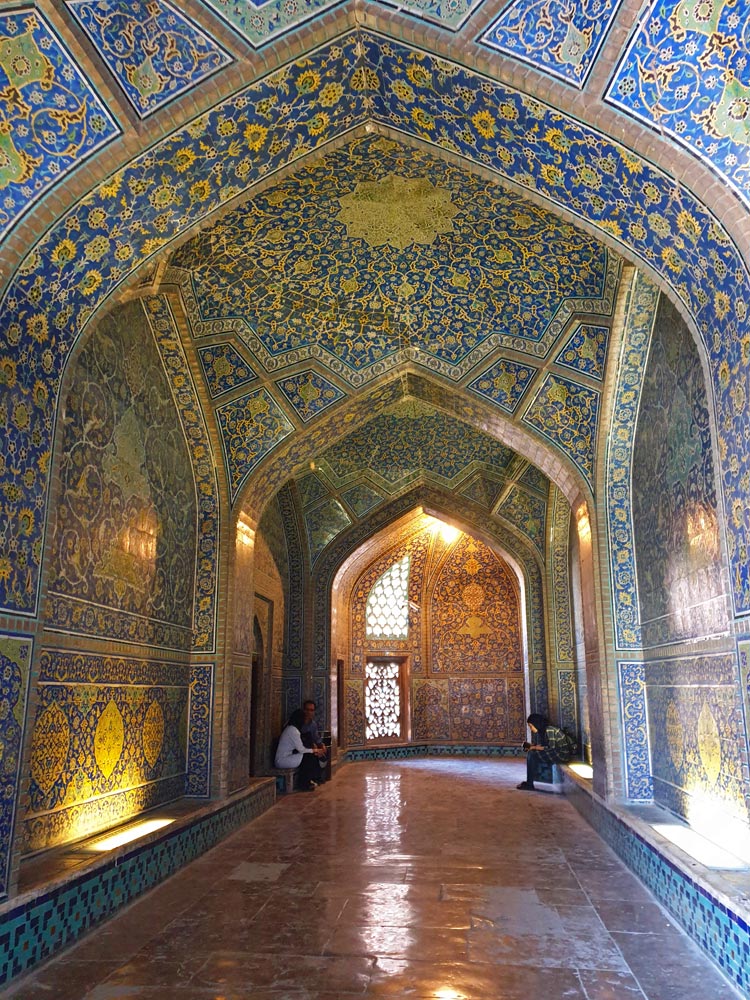

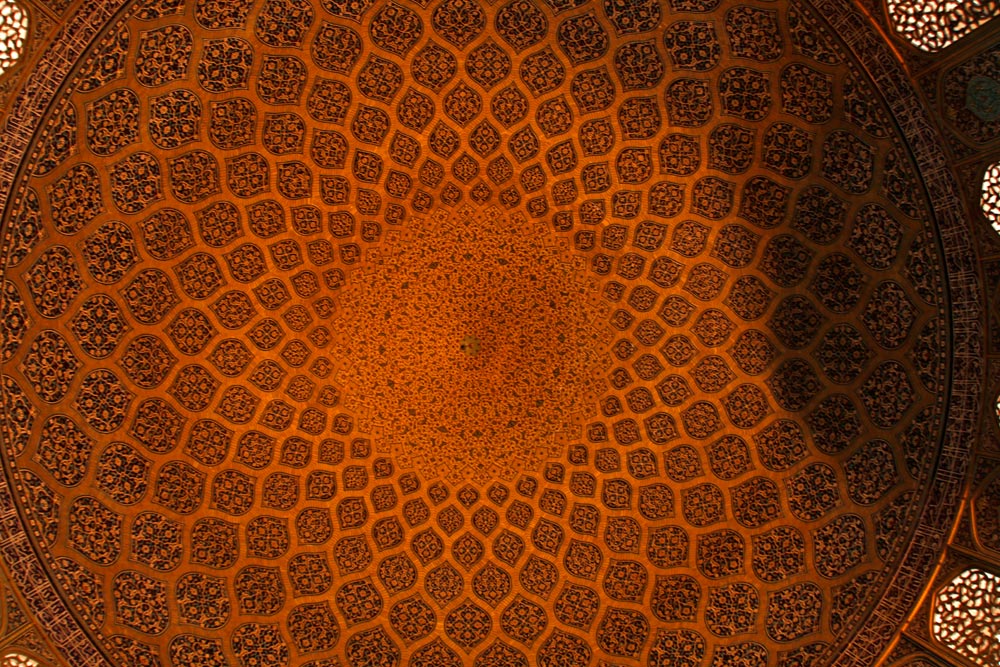

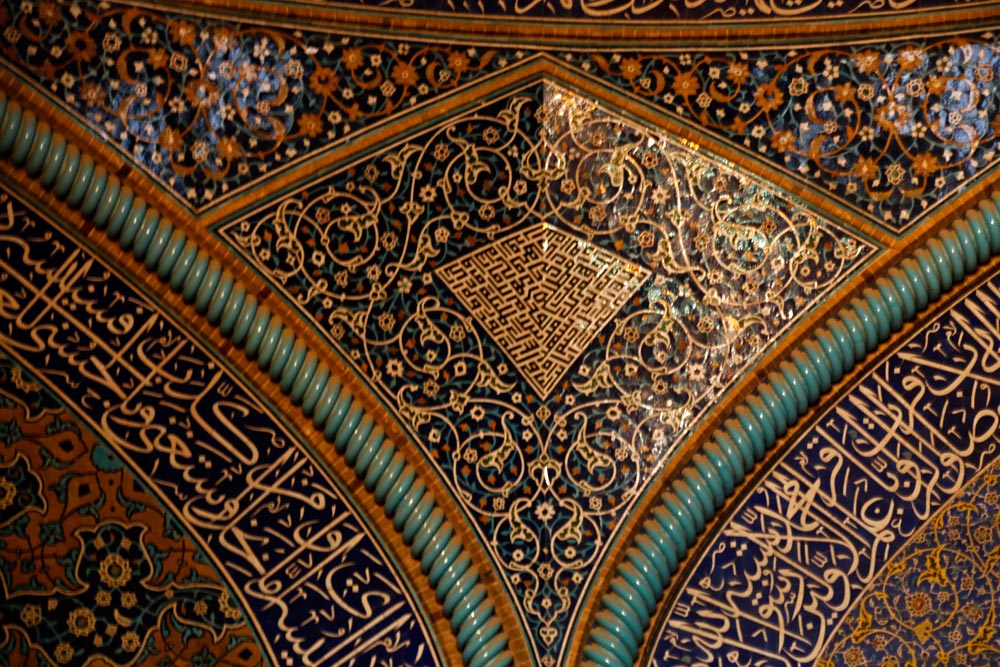
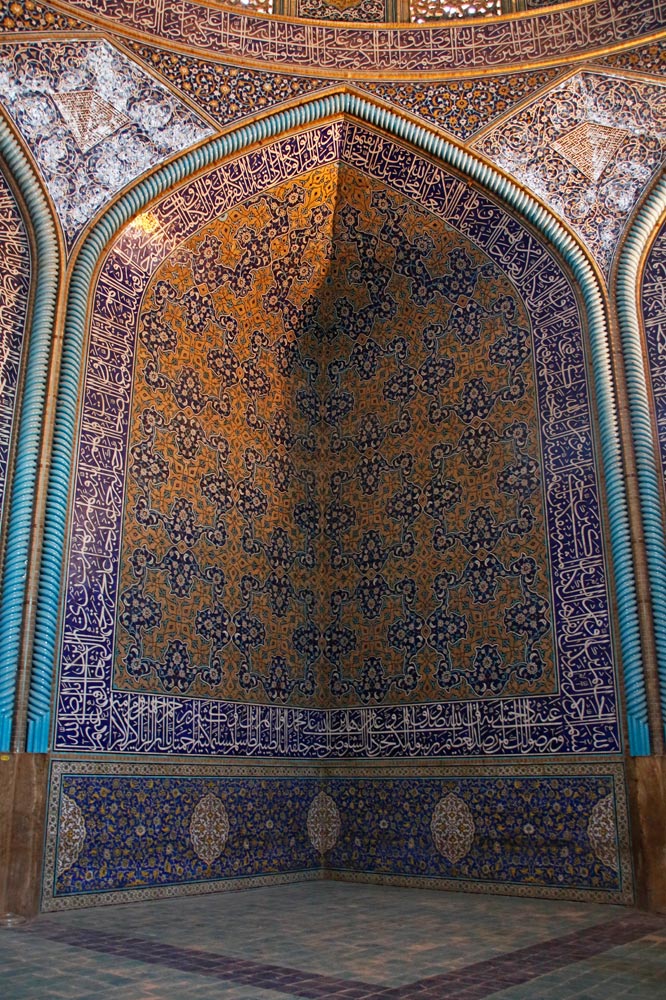

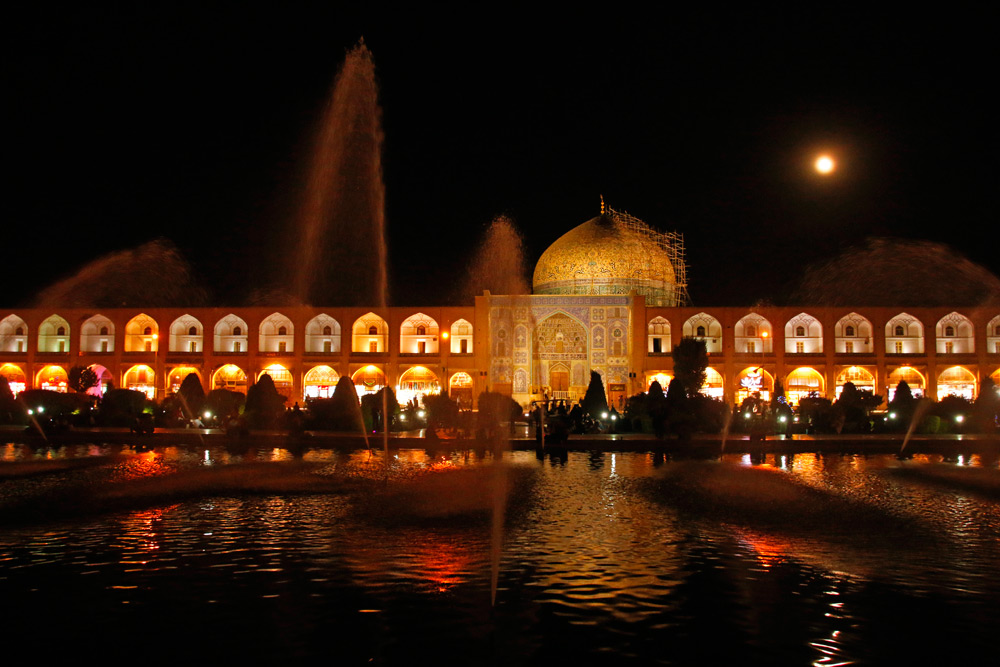
Shah Mosque or Abbasi Great Mosque
The Shah Mosque, also known as Abbasi Great Mosque, New Abbasi Mosque or Royal Mosque, is considered a masterpiece of Persian architecture and is located on the south side of Naqsh-e Jahan Square. The mosque is decorated in various shades of blue, turquoise and yellow and decorated with floral and tendril ornaments and Koran inscriptions by the calligrapher Ali Reza. It consists of eighteen million bricks and 500,000 seven-colored faience tiles. You can also find this architecture on the older mosques and mausoleums in Samarkand and Bukhara in Uzbekistan.
You enter the mosque through the 27 meter high entrance portal with its filigree muqarna vault. It is entirely decorated in shades of blue and decorated with tiled mosaics. It is framed by two minarets, each 48 meters high, which, like the other buildings of the mosque and its courtyard, are at a 45° angle to the two minarets next to the prayer hall in the courtyard. This architecture was necessary to align the actual building with Mecca.
Behind the impressive entrance portal you can see the imposing, 54 meter high dome. This makes it the tallest dome in the city. In addition, the four impressive Ivans await you with their large gates. Ivans are the most important buildings of a mosque or palace. For climatic reasons, the Shah Mosque was built in the Four Ivans style to protect the believers from the heat in summer and the cold in winter. The Ivans are erected in all four cardinal directions. The most significant are the southern buildings of the Shah Mosque. Two 48 meter high minarets tower over the fascinating South Ivan. Crossing it takes you to the dome hall, the most important room of the southern part of the mosque. There are also two madrasahs in the mosque complex – the Medrese-ye Soleimani and the Medrese-ye Naseri – as well as several prayer halls.
Shah Abbas I of Persia had the Shah Mosque built from 1612 to 1630 during the Safavid Dynasty. He himself died a year before its completion.
- Address: South side of Naqsh-e Jahan Square, Isfahan, Iran.
- Opening Hours: 9:00 AM to 5:00 PM. Non-Muslims must leave the mosque during prayer times.
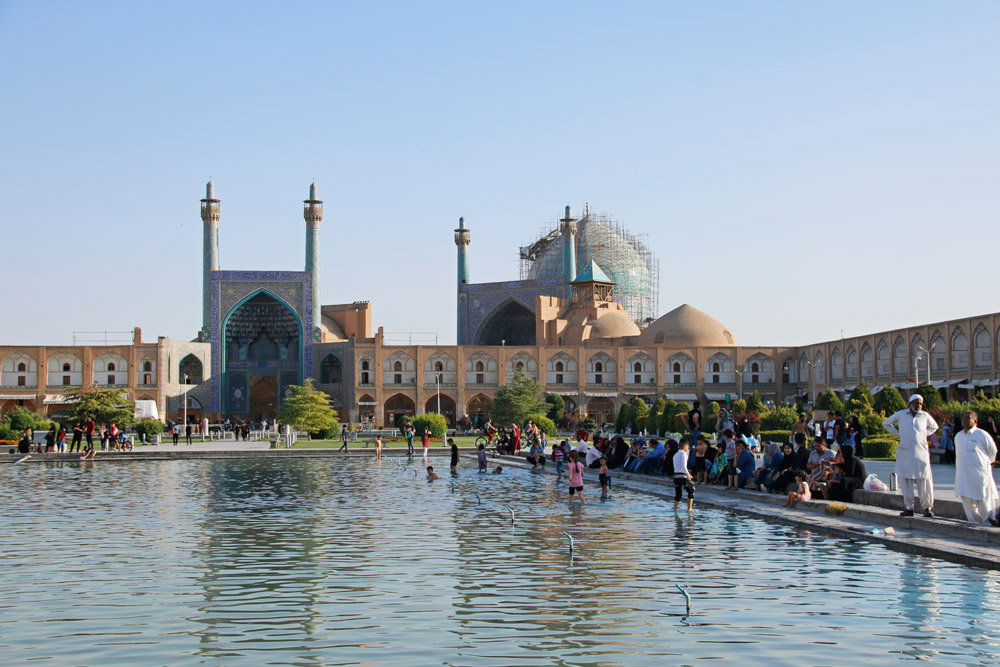

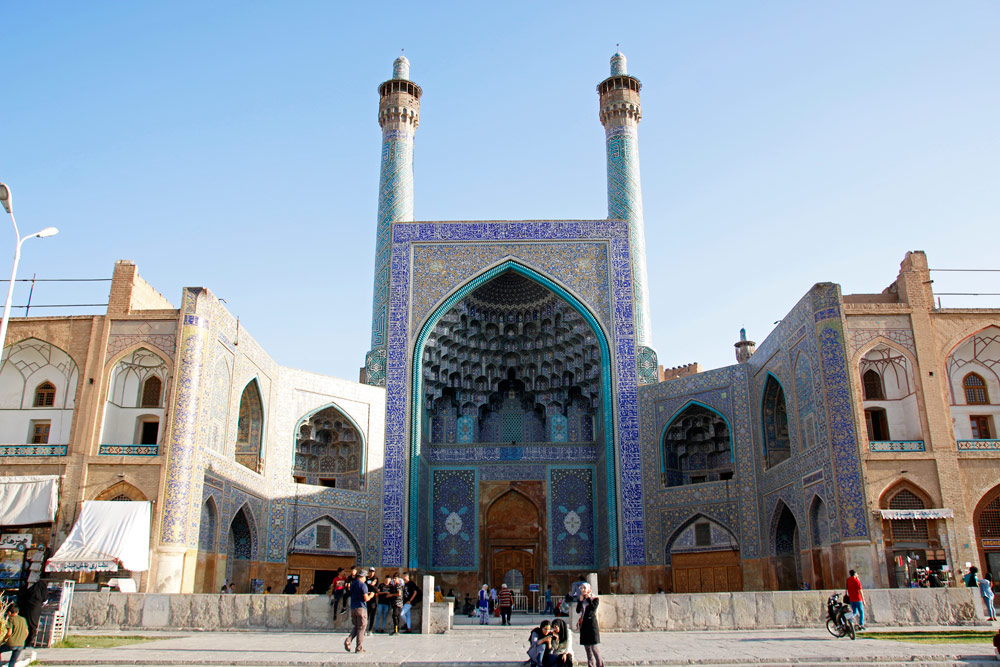

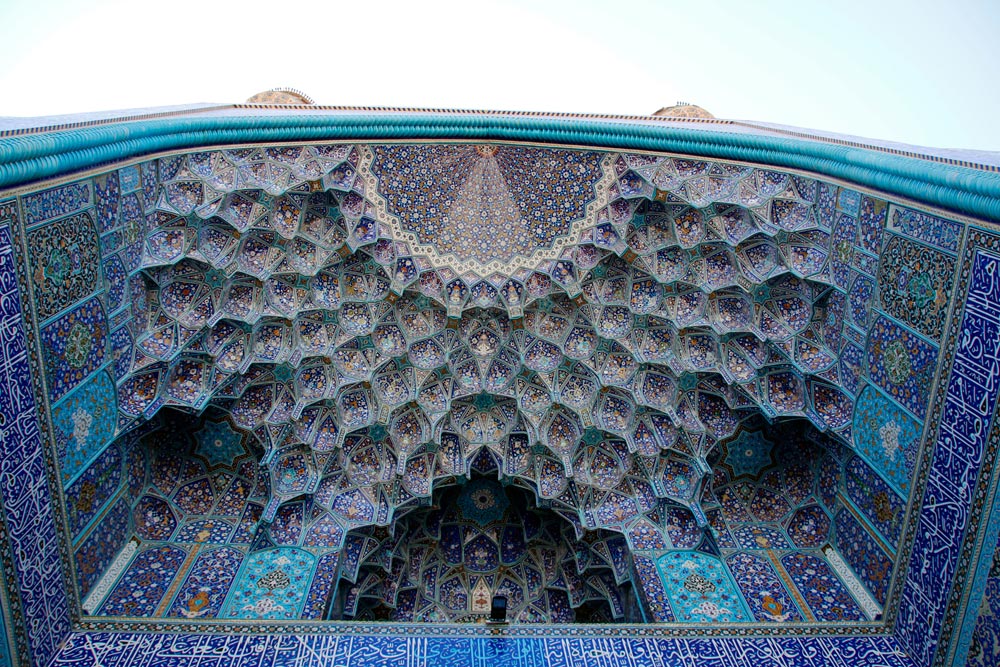
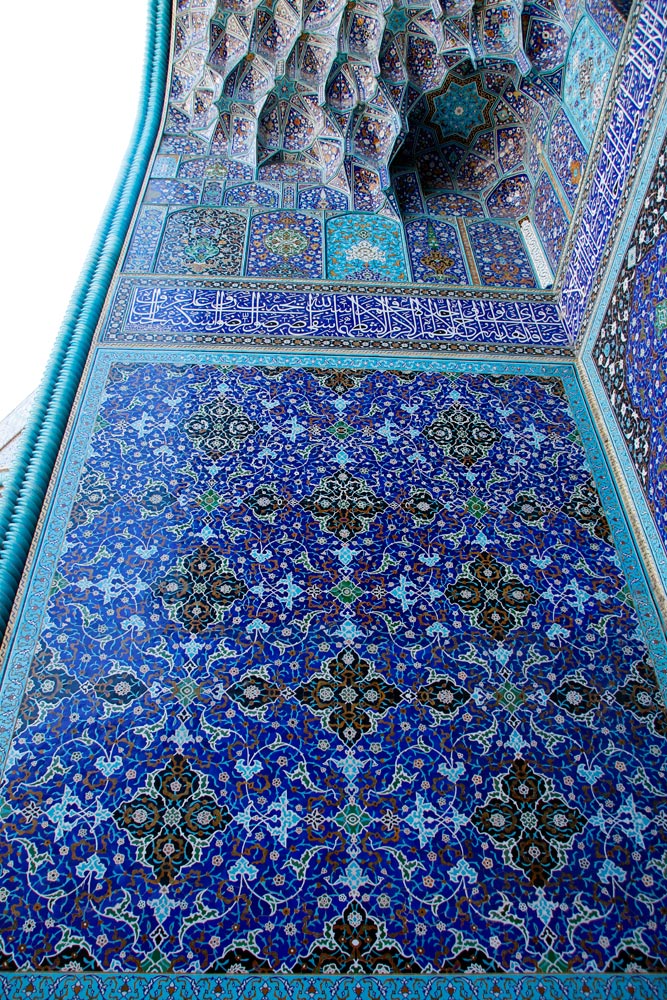
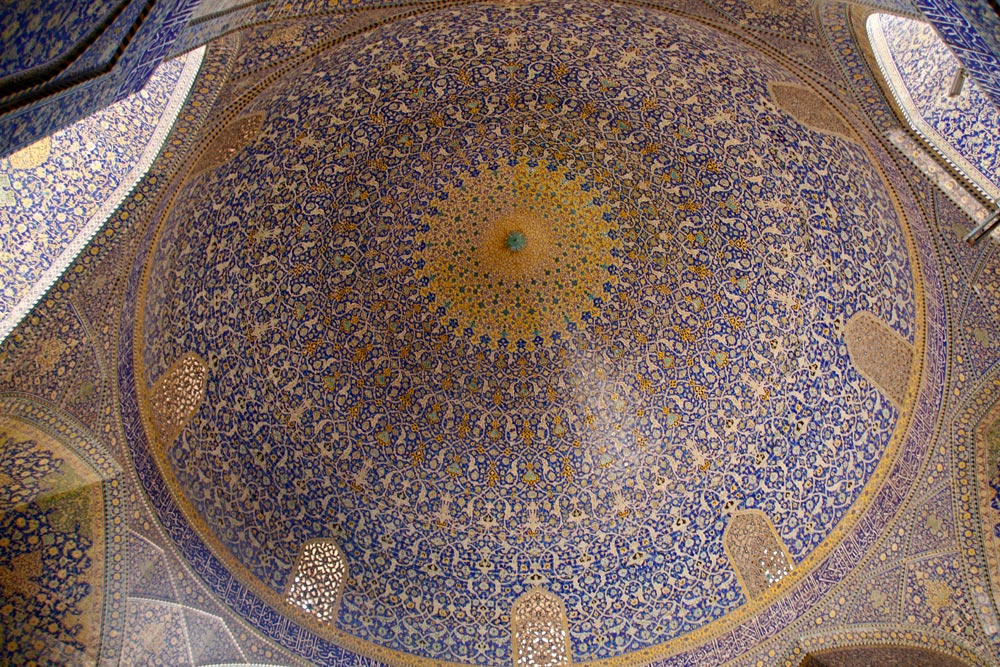
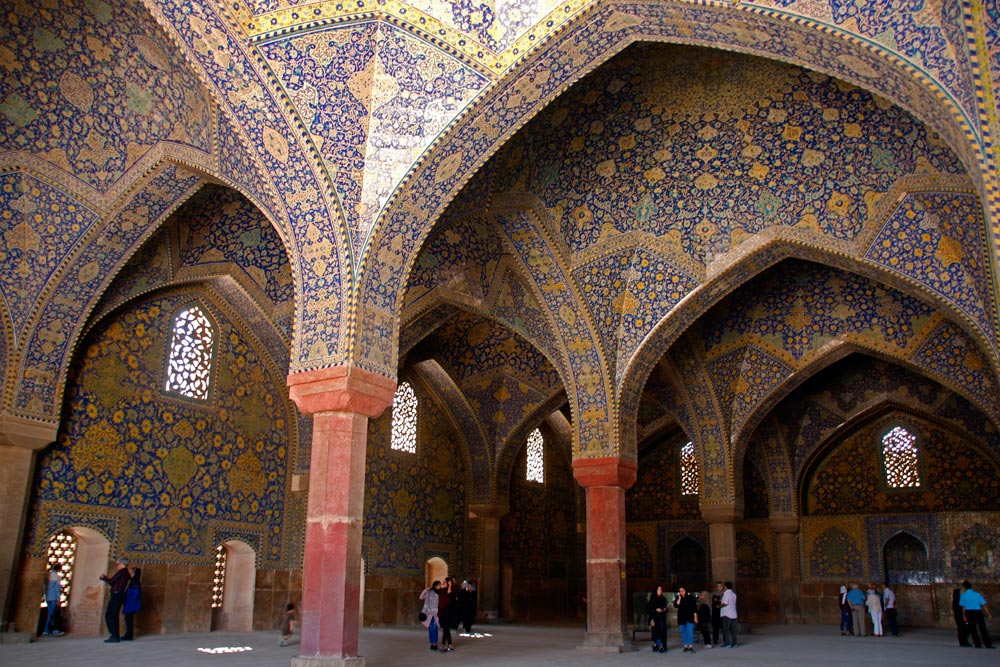
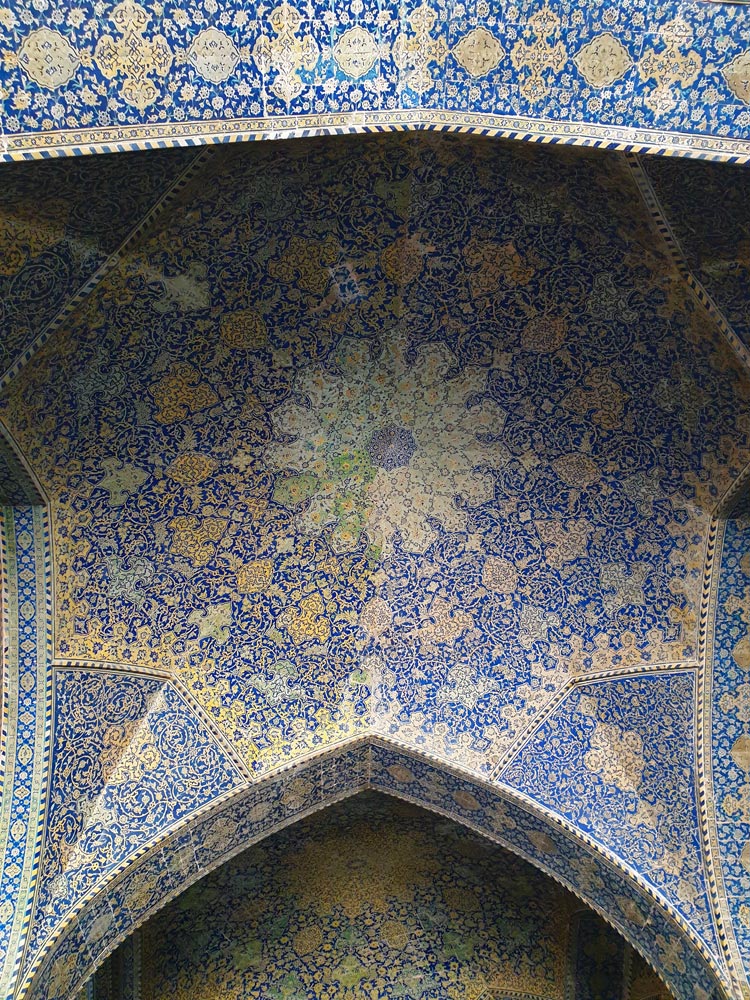
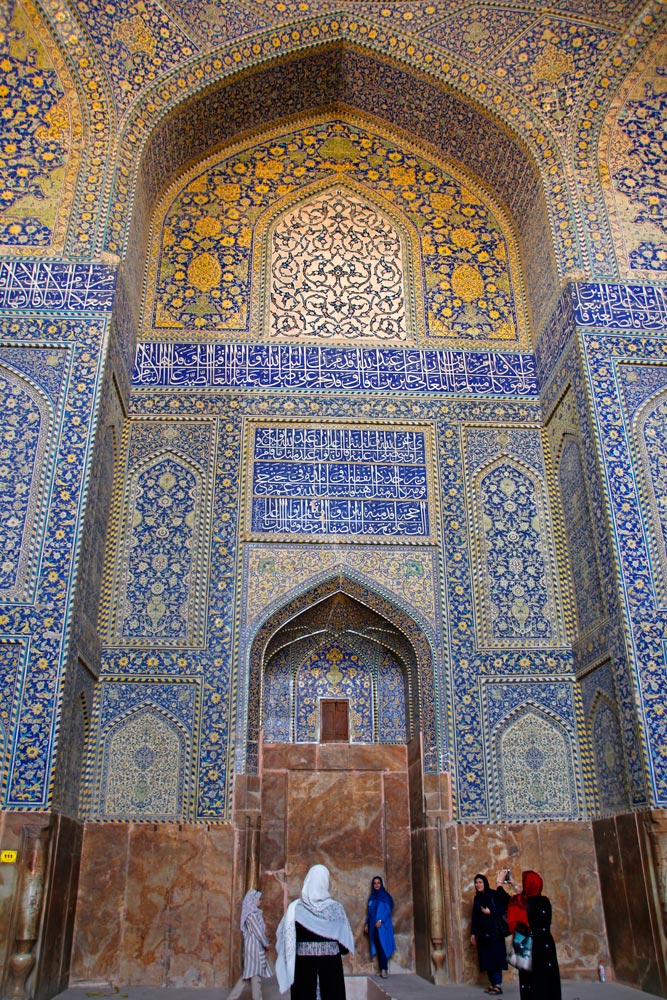
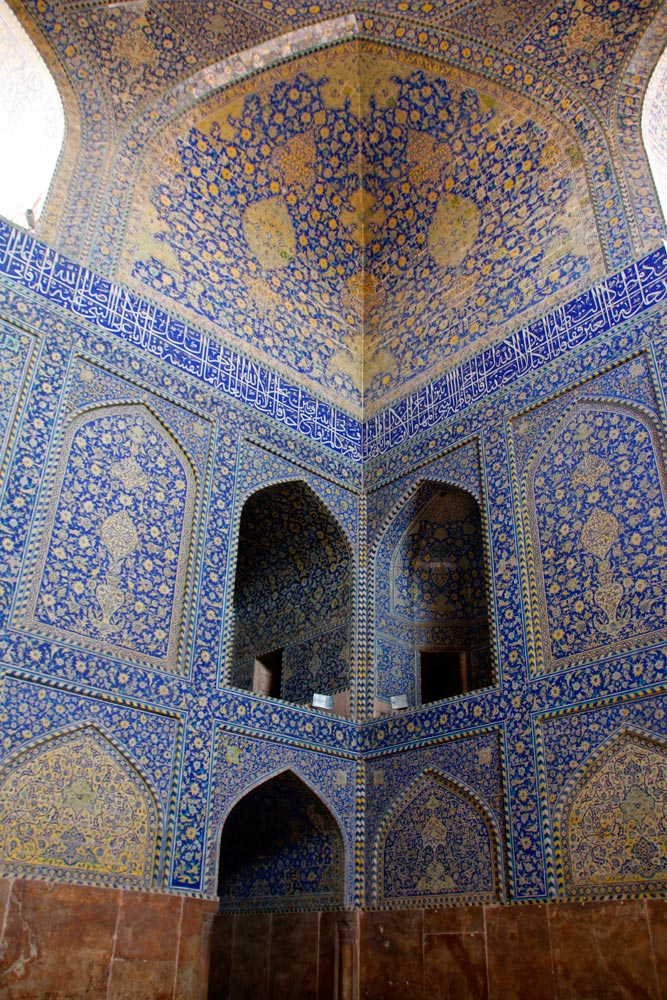
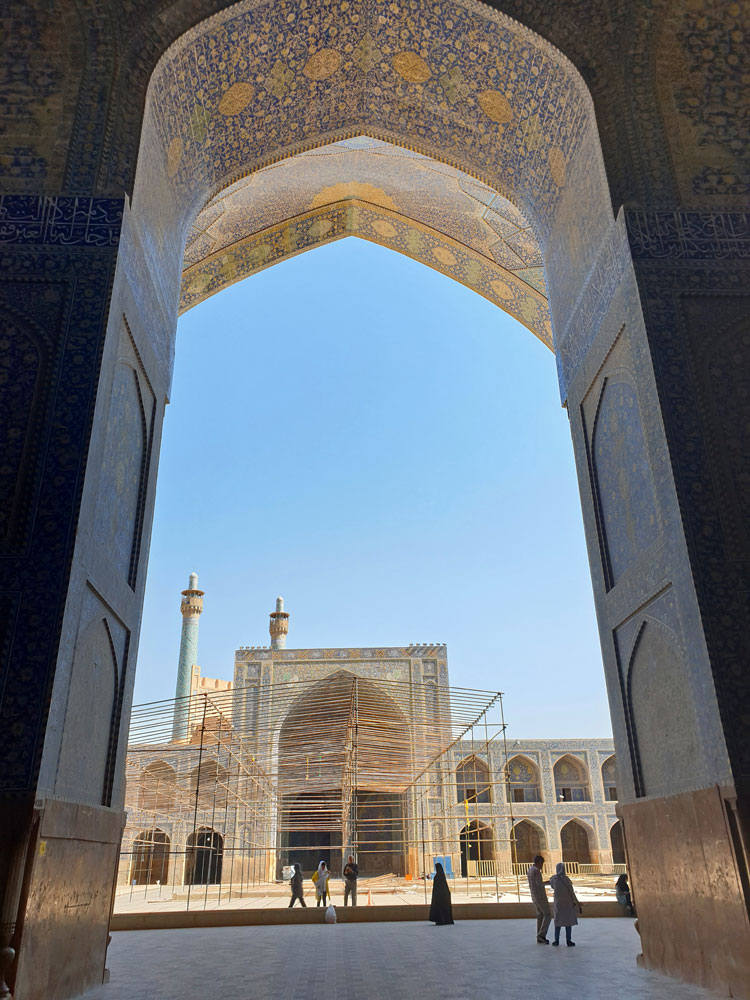
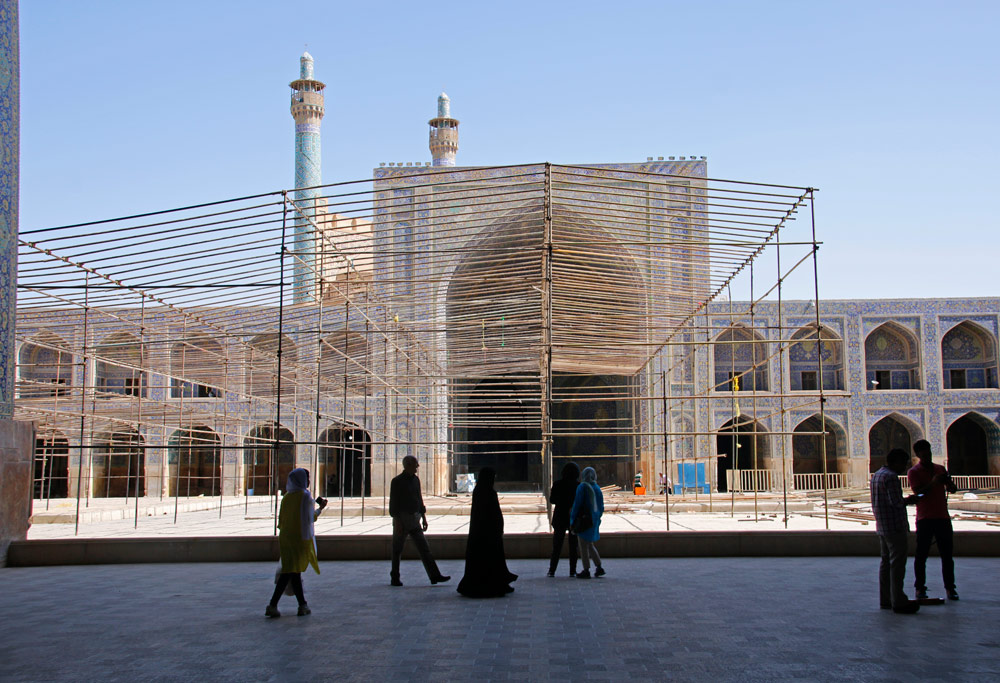
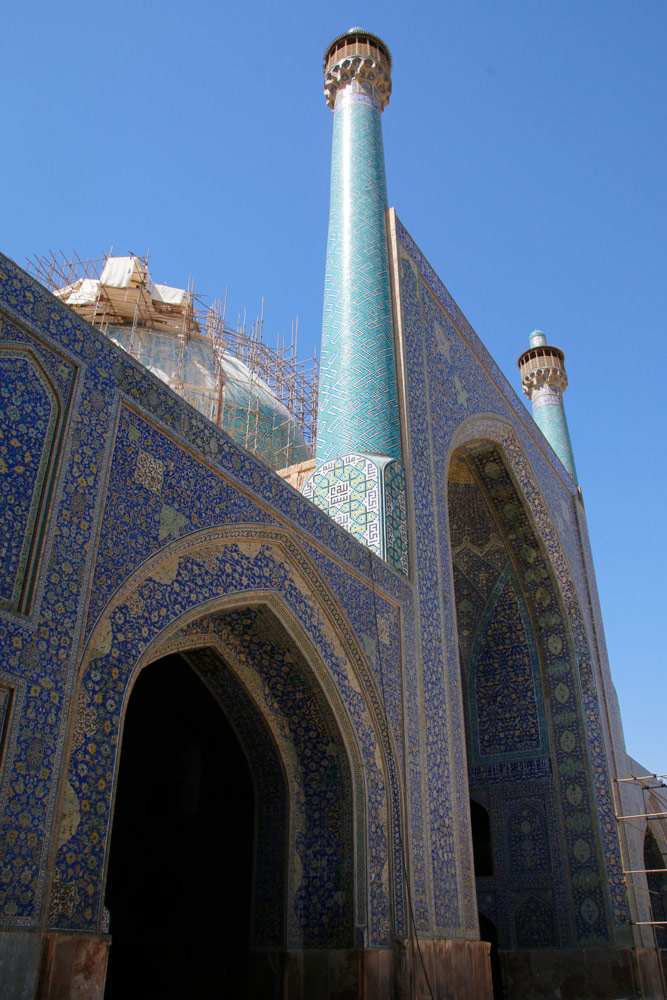

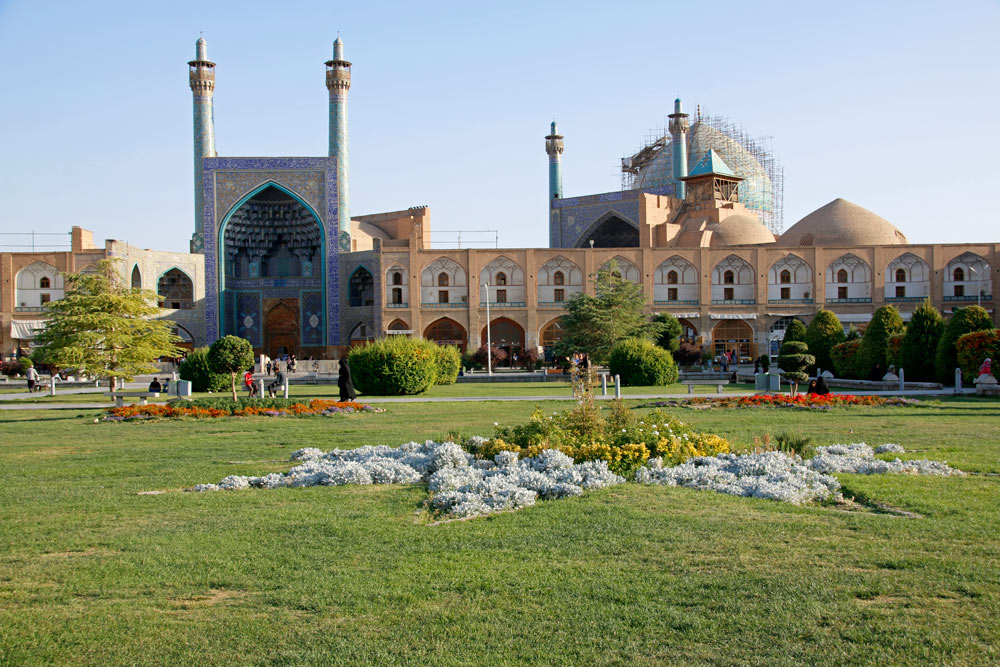
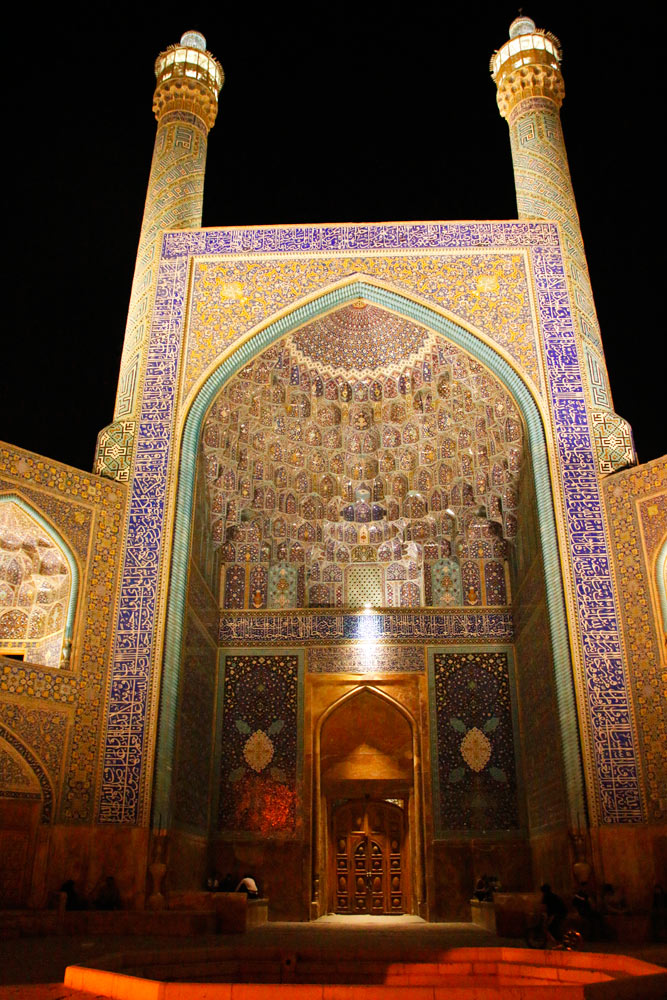
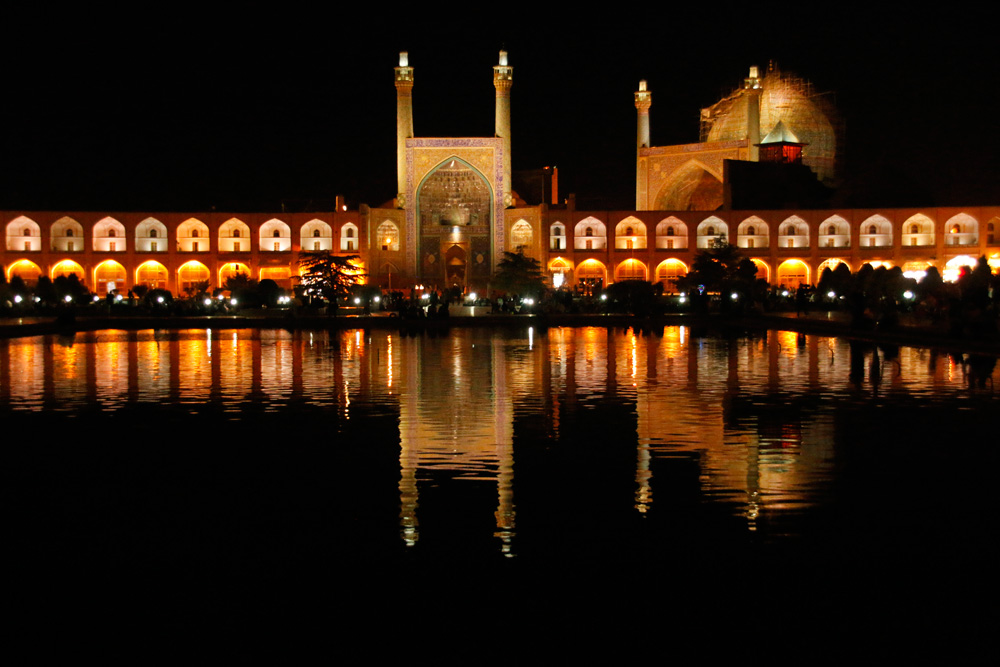
Ali Qapu Palace
The Ali Qapu Palace or Kakh-e Ali Qapu is located on the western side of Naqsh-e Jahan Square. Ali Qapu means High Gate. From the porch of the Ali Qapu Palace you have a fantastic view of the entire square and of the Shah and Sheikh Lotfollah Mosques. The wooden roof of the porch is supported by 18 cedar columns. The palace is 48 meters high and has six floors. A narrow spiral staircase takes you to the sixth floor, where the music room is located. It is well worth seeing. Floral patterns and bird motifs adorn the staircase. Bottle and vase-shaped plaster niches are incorporated into the walls of the music room, giving the room a very special charm and excellent acoustics.
Shah Abbas I had the Ali Qapu Palace built in 1597. It served as a connection between the publicly accessible Naqsh-e Jahan Square and the living quarters and gardens of the ruling family. Shah Abbas I and subsequent kings and their families resided on the upper floors of the palace. The lower floors were intended as living quarters for the employees.
- Address: West side of Naqsh-e Jahan Square, Isfahan, Iran.
- Opening Hours: 9 AM to 1 PM and 4 PM to 8 PM.
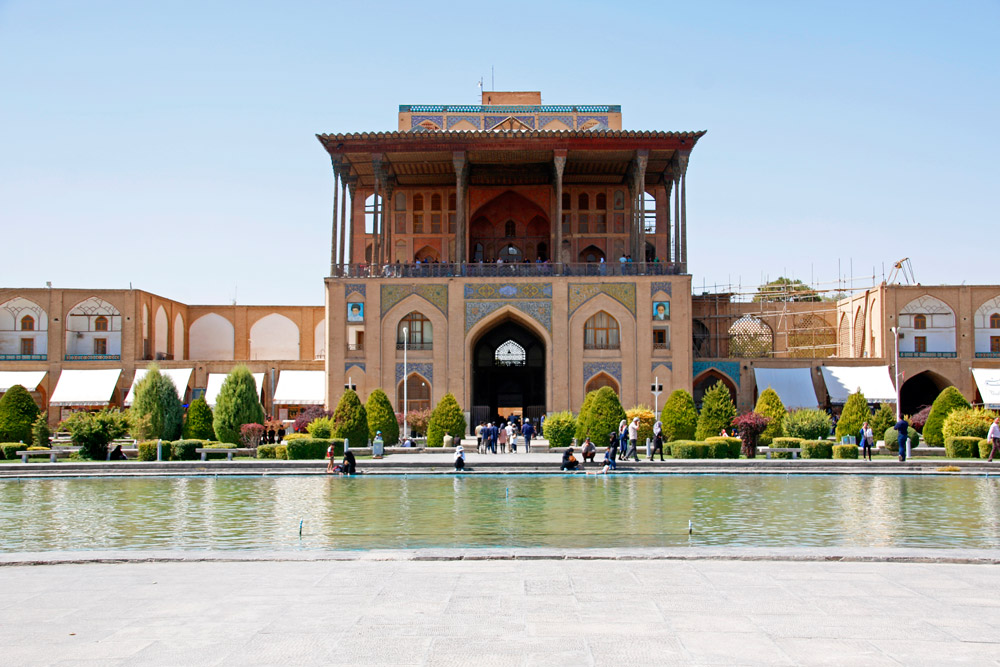
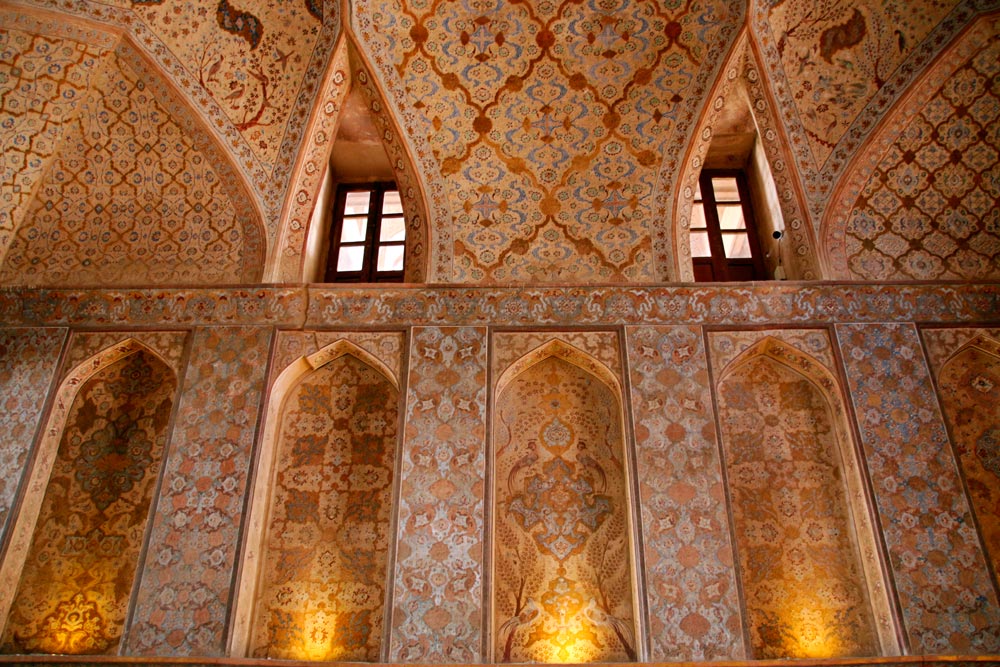
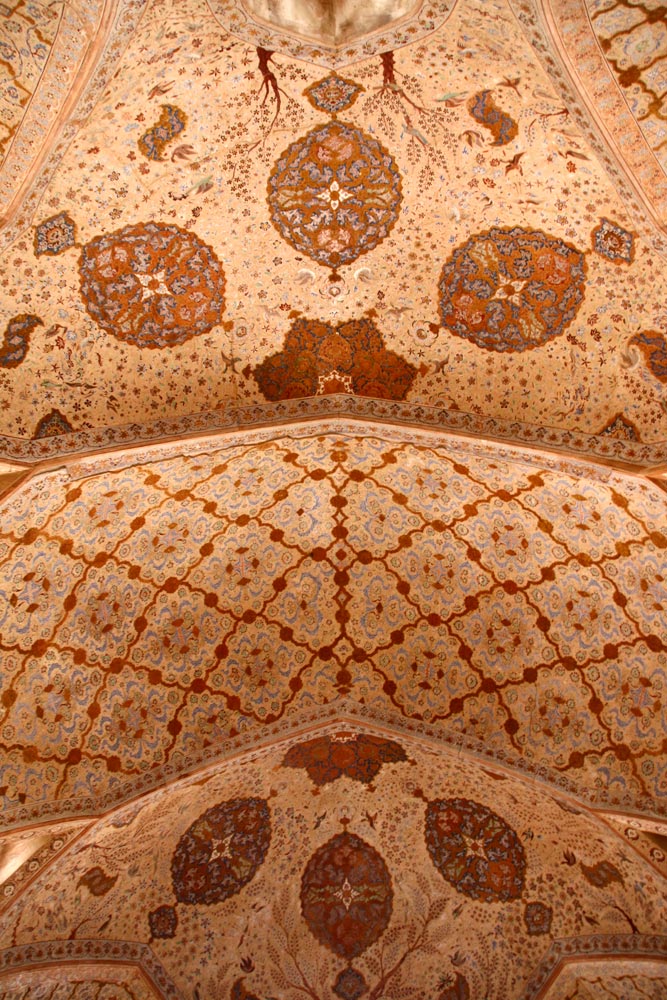
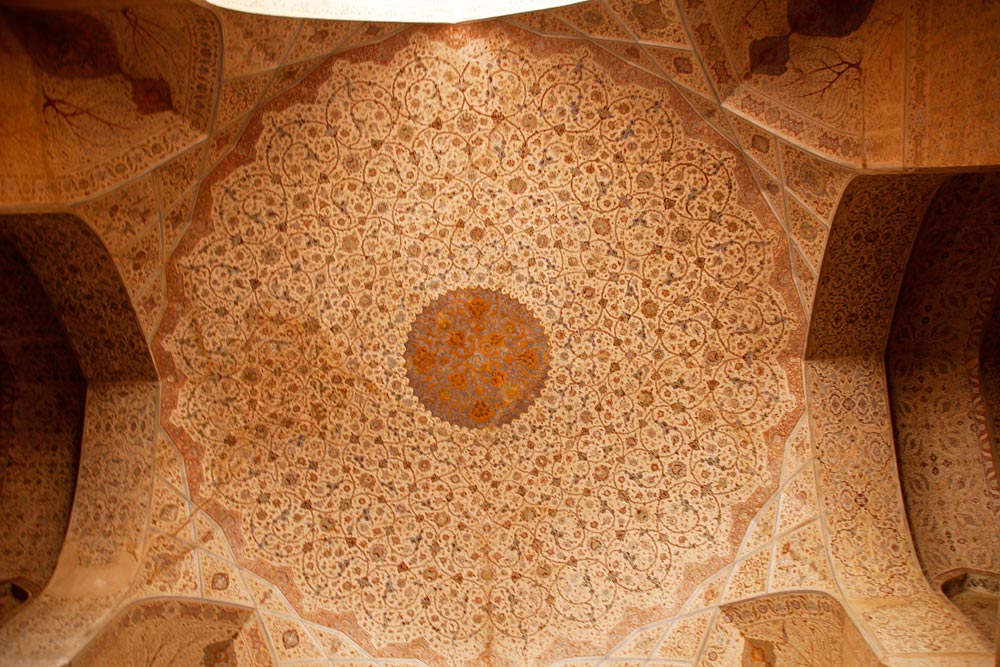
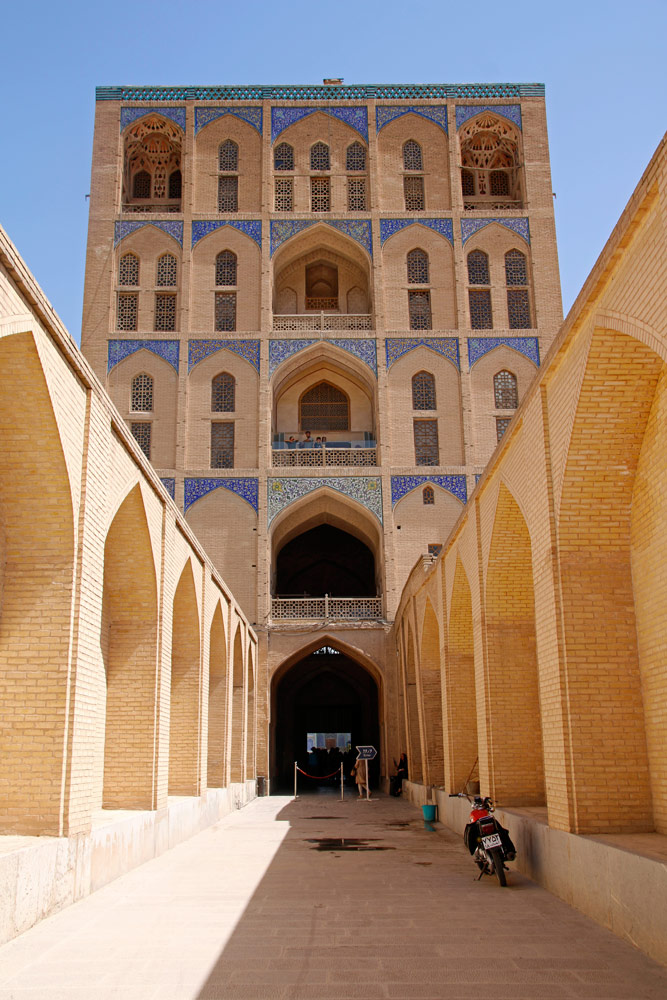
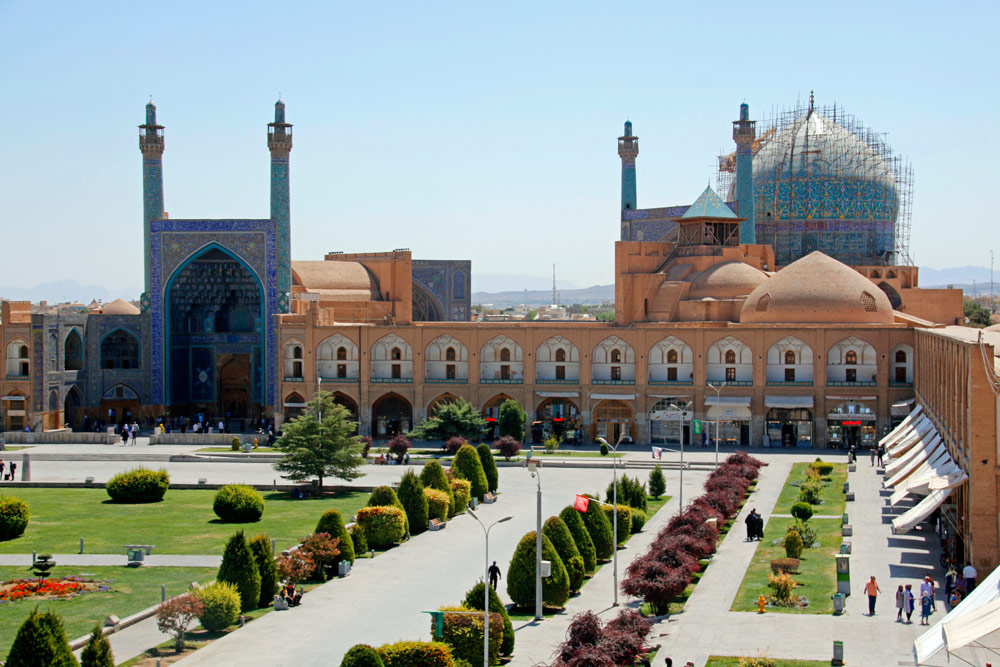
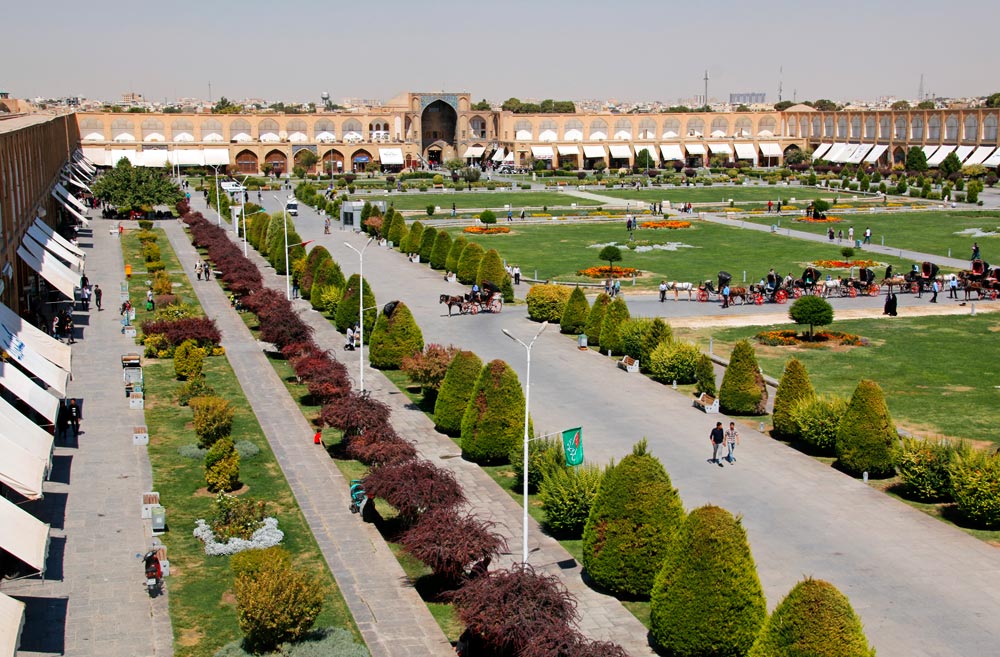
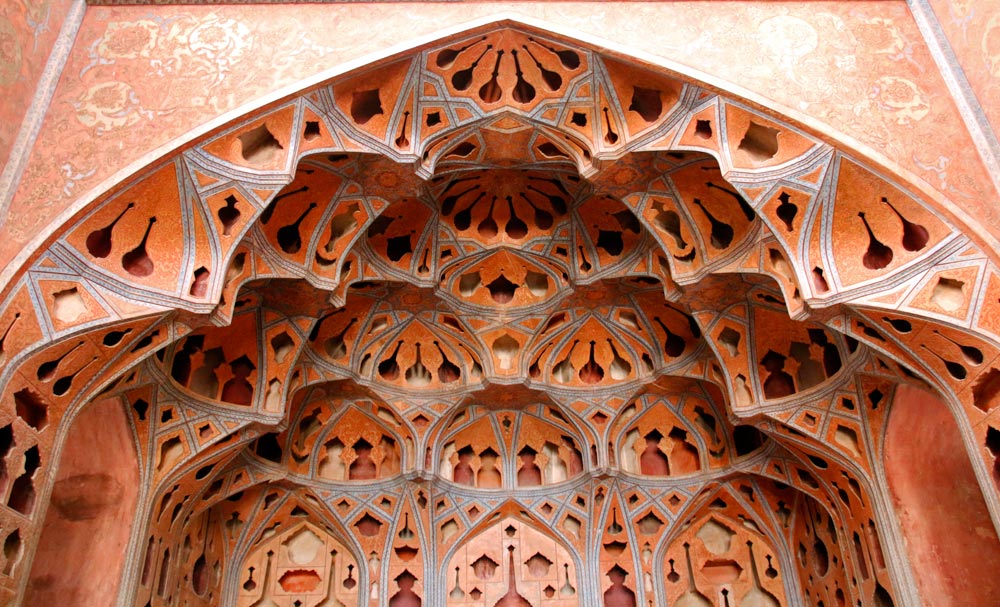
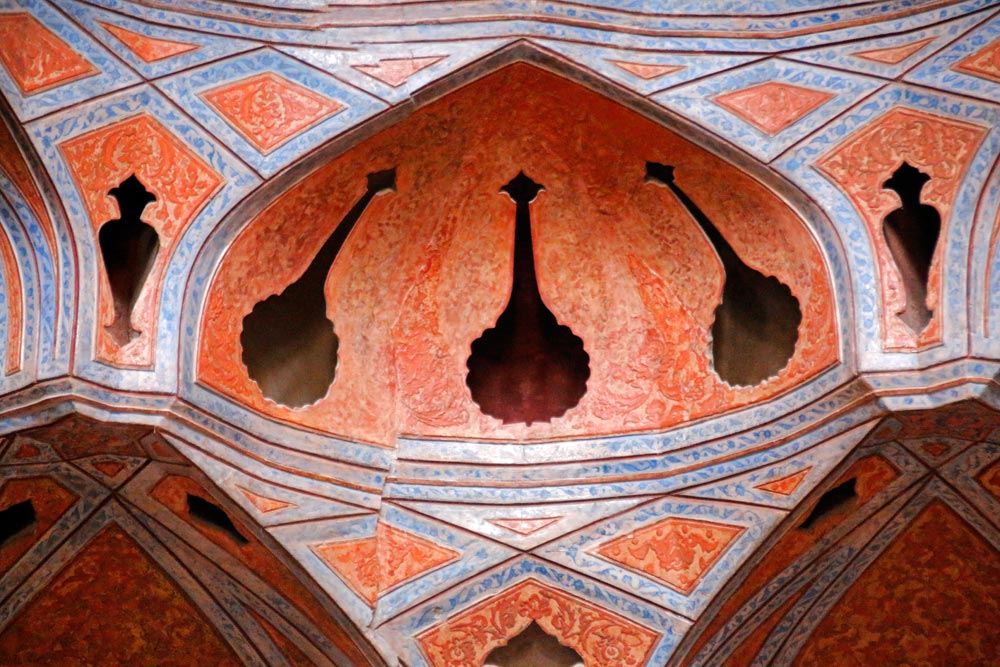
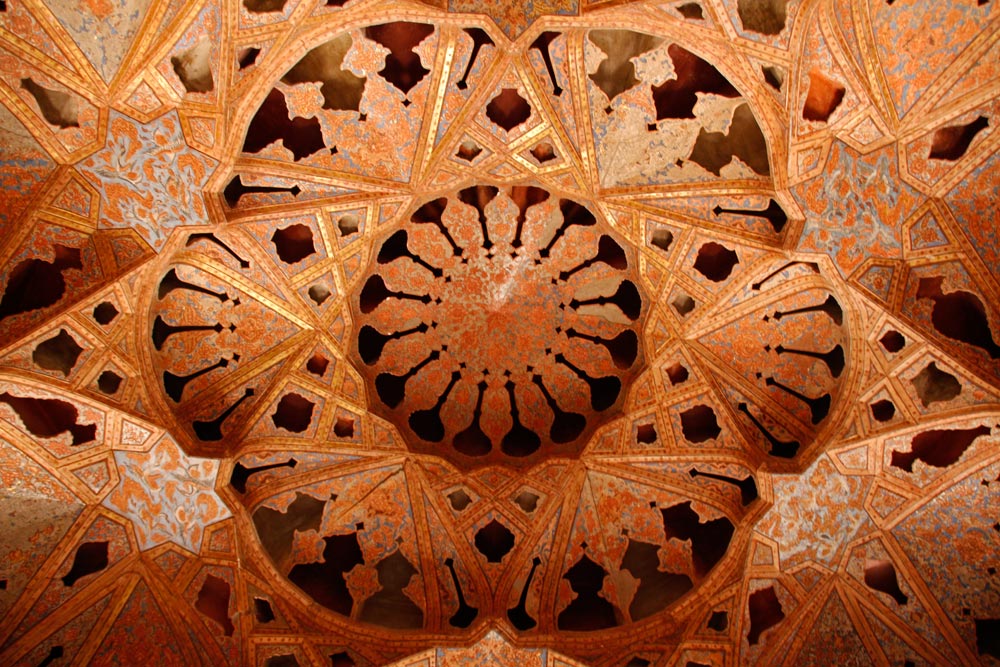
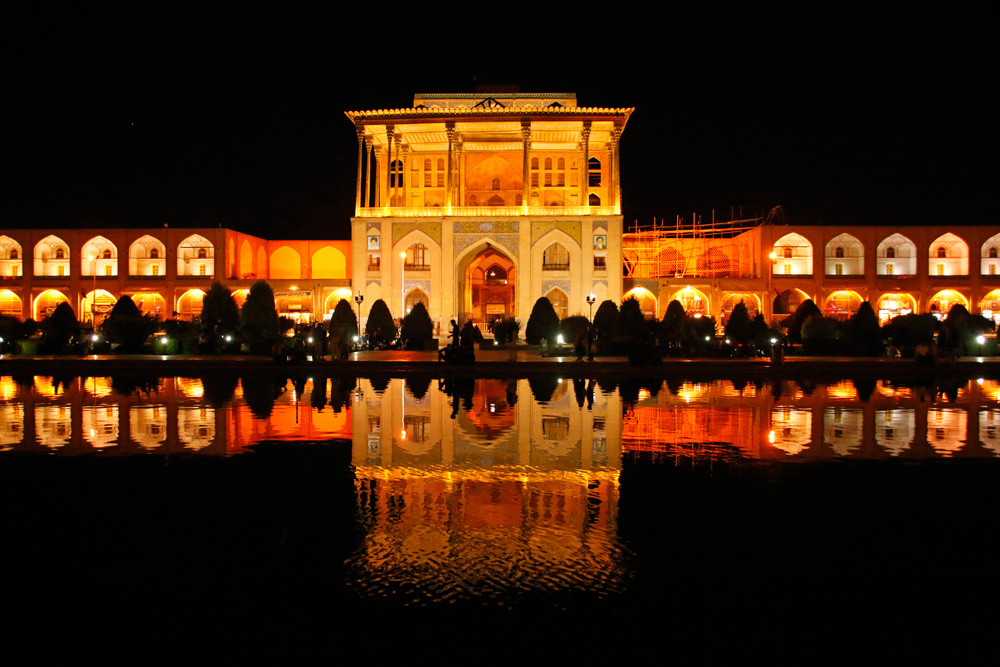
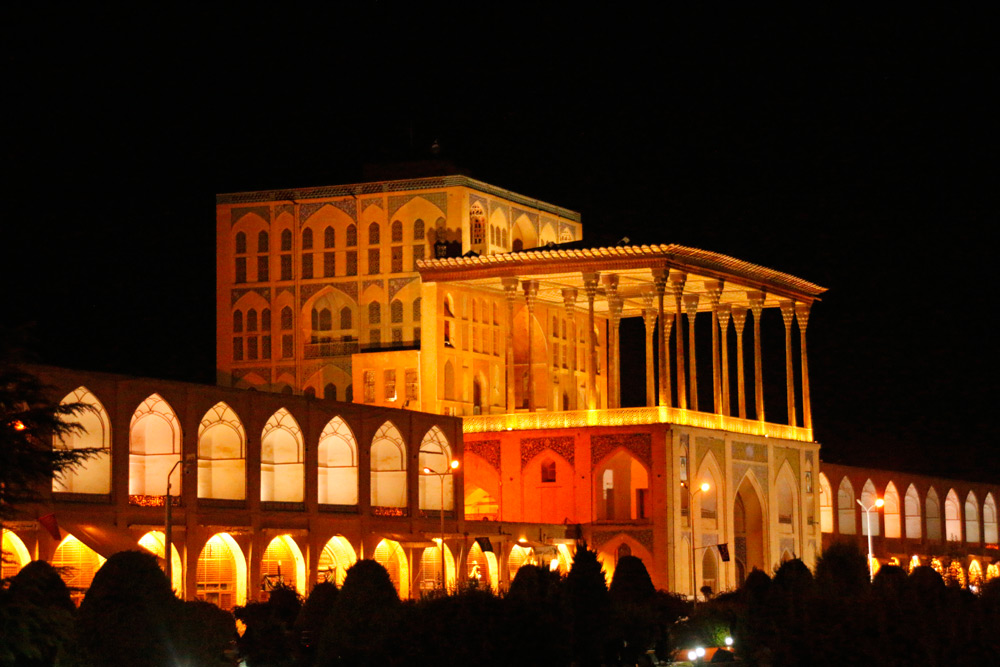
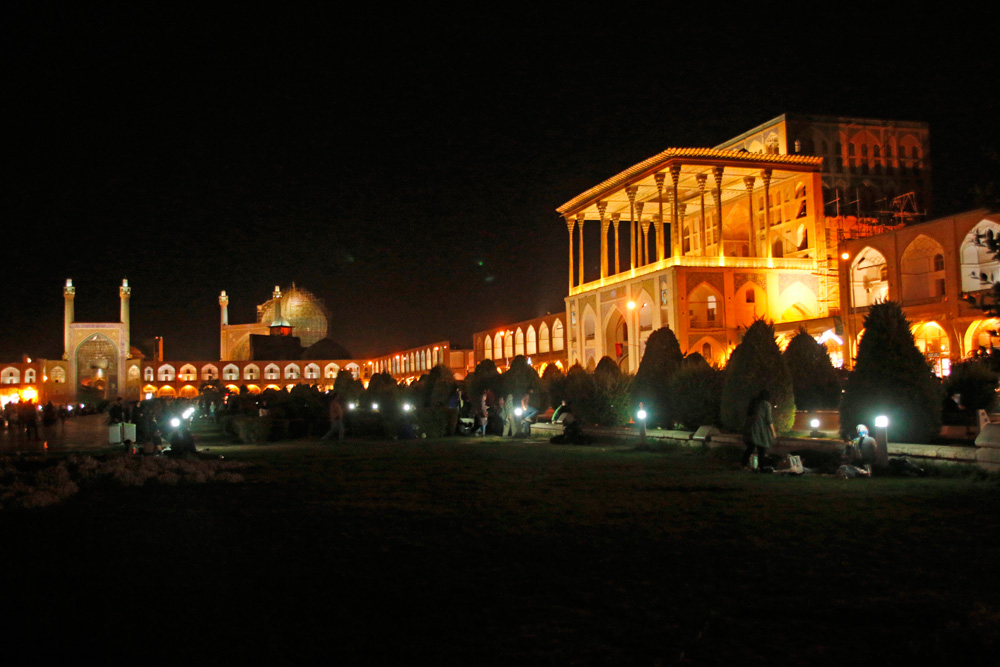
Arcades
The two-storey arcades stretch around the entire Naqsh-e Jahan Square. Here you will find numerous small handicraft and souvenir shops where you can buy everything from brass work, Persian carpets, handicrafts, painting, enamel, wood and inlay work. Although souvenirs in Isfahan are more expensive than in other parts of Iran, they are also particularly beautiful here. It is worth comparing the choices in the arcades and in Isfahan’s Grand Bazaar.
If you enter the arcades 200 meters north of the Ali Qapu Palace, you will enter the Coppersmiths’ Bazaar. Here you can watch the coppersmiths at work. You can also hear the hammering and knocking of the artisans in other places in the arcades.
- Around Naqsh-e Jahan Square, Isfahan, Iran.
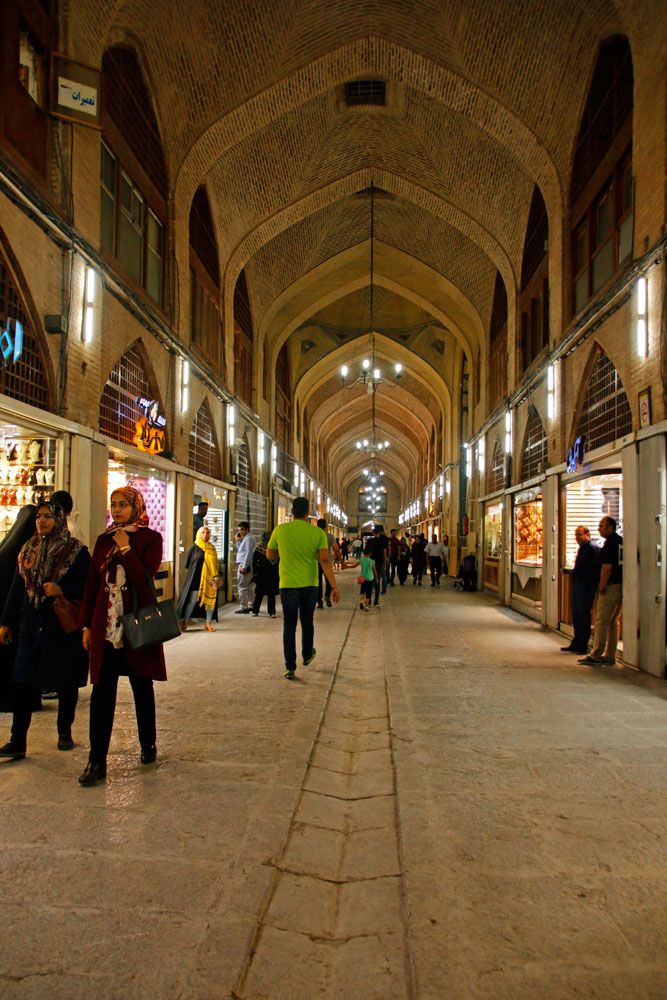
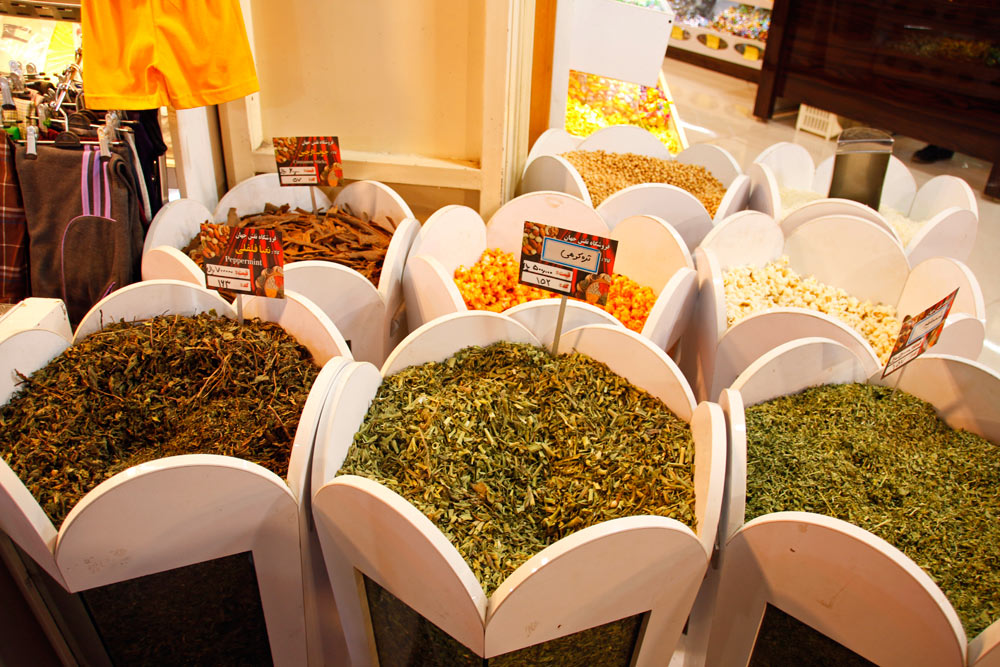
Grand Bazaar
Isfahan’s Grand Bazaar is also called Bazaar-e-Bosorg and is one of the largest and busiest bazaars in Iran. The bazaar streets are mostly covered and stretch for a kilometer and a half from the middle of the north side of Naqsh-e-Jahan Square to the Friday Mosque. Here you can buy almost everything from handicrafts to carpets to household appliances.
The bazaar is divided into three areas. If you enter it from Naqsh-e-Jahan Square, you will enter the Bazar-e Qeysariyeh also known as the Imperial Bazaar. The entrance portal is decorated with tiled mosaics and fresco paintings. This part of the bazaar has two floors and is partially up to 180 meters wide. Inside you will find numerous crossings covered with domes. Furthermore, there are the Hall Timcheh Malek with some domes and a courtyard and a historic oil press. This part of the bazaar was built between 1602 and 1619 at the behest of Shah Abbas I.
In the northern part of the Grand Bazaar is the Madrasa Sadr with its beautiful courtyard. It is the largest historical medrese of Isfahan from the 19th century. Northeast of it is the three-domed Timche Haj Karim hall. 200 meters south-east is the Saray-e Sarutaqi courtyard with a 30 square meter inner courtyard and two side courtyards. The Grand Vizier Sarutaqi had it built in 1646. In this part of the bazaar you can also visit the Madrasa Nimavard with its beautiful tiles, muqarnas, stucco and Nastaliq scrolls.
In the western part of the bazaar, the Hakim Mosque awaits you with beautifully decorated tiles, mihrabs and muqarnas. The mosque was built in 1656 at the instigation of Hakim Mohammad Davud, the court physician of Shah Abbas I. There are also numerous carpet shops in this area of the bazaar.
- Address: Between the north side of Naqsh-e-Jahan Square and Jame Mosque, Isfahan, Iran.
- Opening Hours: Monday to Sunday from 10 AM to 8 PM.
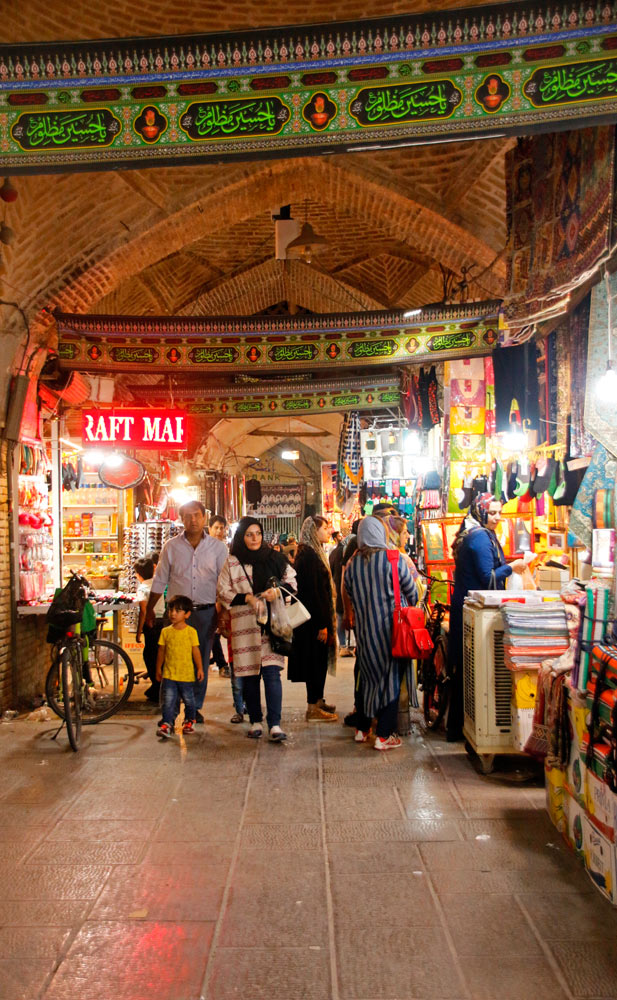

Jame Mosque or Friday Mosque
Jame Mosque, also known as Atiq Mosque or Friday Mosque, is Iran’s largest mosque, covering an area of two hectares. Located northeast of Isfahan’s Grand Bazaar, it has been a UNESCO World Heritage Site since 2012. Just like the Shah Mosque, the Jame Mosque is also a four Ivan mosque. All four Ivans are elaborately decorated with Muqarnas.
The South Ivan is also decorated with enchanting, turquoise tile decorations and is framed by two 35 meter high minarets. It is considered the most beautiful of the four Ivans. Behind is the domed building Nizam ol-Molk, named after the vizier Nizam ol-Molk. The dome of this prayer hall has a diameter of 13.5 meters.
The West Ivan is decorated with geometric tile decorations and has a wooden gold asteh on its roof. The muezzin used this to call the faithful to prayer. From the West Ivan you get to the three-aisled winter prayer hall from 1448, which is called Shabestan because of its uniform pillars. The prayer room to the right of the West Ivan has two wooden minarets and is decorated with an intricate stucco mihrab dating from 1310.
The North Ivan is kept in natural colors and is decorated with unobtrusive tiles. The domed building Taj ol-Molk behind is only decorated with a surrounding Kufi inscription. However, despite the lack of tile decoration, it is an imposing structure.
The East Ivan is decorated with a band of white tiles in Thulth script on a blue ground and with decorations dating from between the 8th and 10th centuries. Behind the East Ivan is a madrasa with beautifully decorated tiles dating back to 1375.
Also on the Jame Mosque grounds is a portico with numerous domes and patterned bricks. Just like Naqsh-e Jahan Square, the entire area of the Jame Mosque is framed by arcades.
A visit to the Jame Mosque will take you on a journey through several eras of Iranian architecture. The original Arabic column mosque was destroyed by fire in 840 and rebuilt as the Four Ivan Mosque by the Seljuks, an ancient Turkish ruling dynasty from the Near East between the 8th and 10th centuries.
- Address: Majlesi St, MM9P+V3C, Isfahan, Iran.
- Opening Hours: Monday to Sunday from 6 AM to 8 PM.
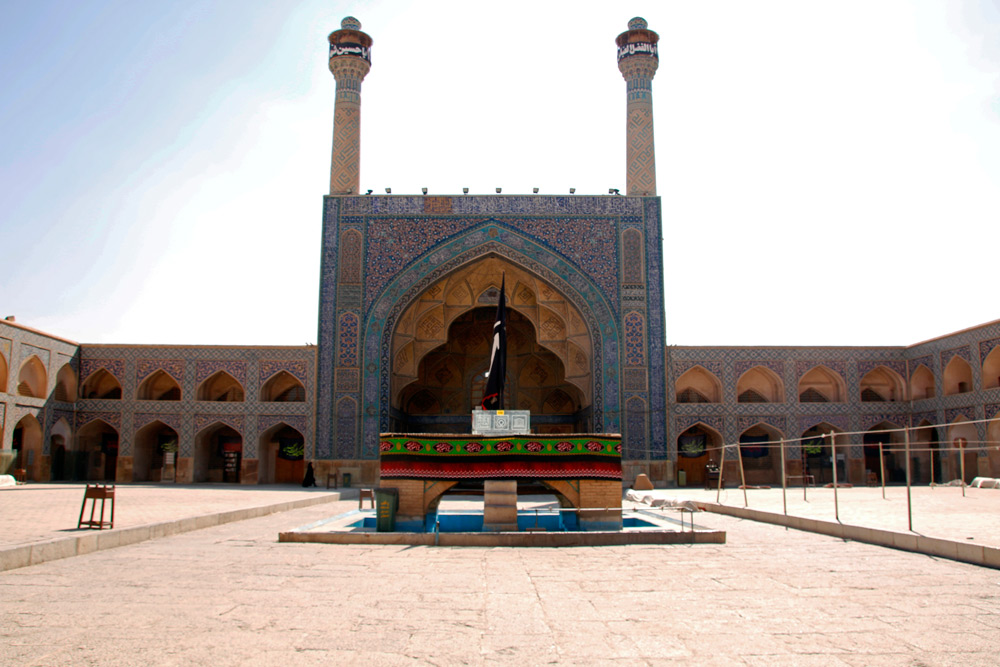

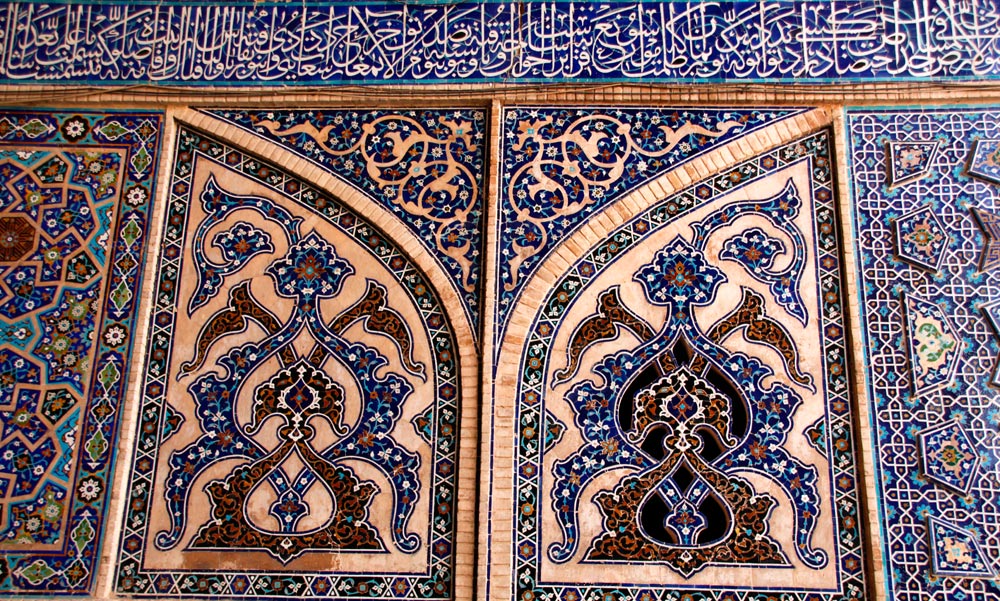
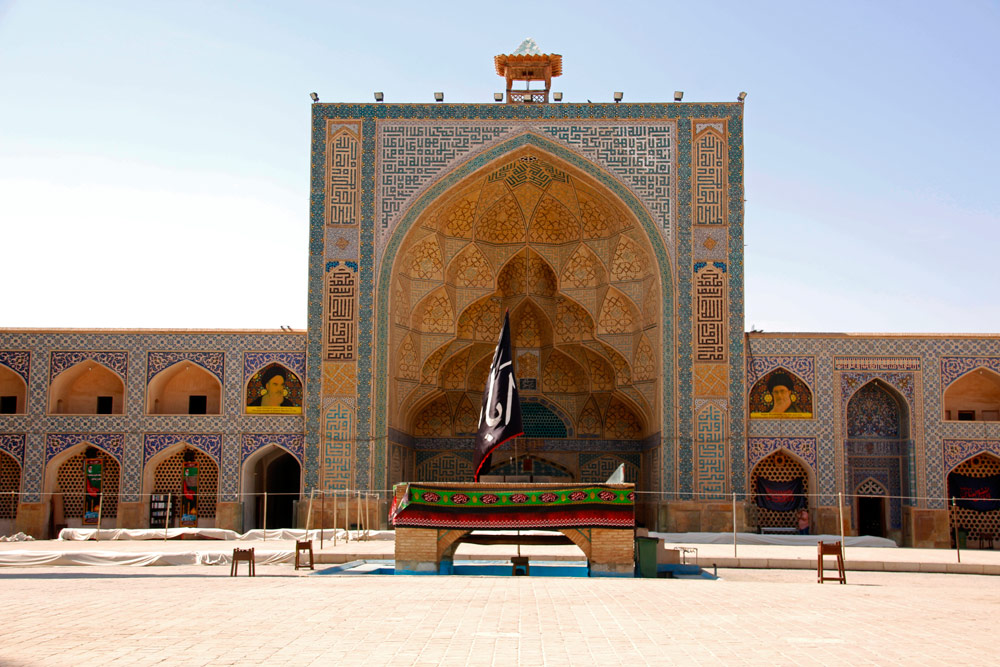
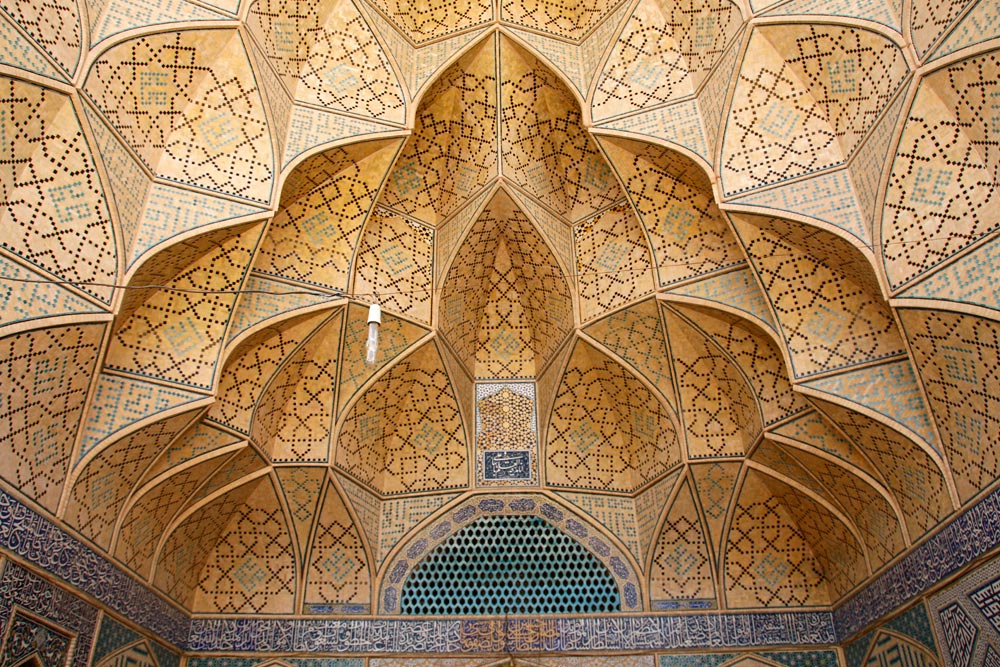
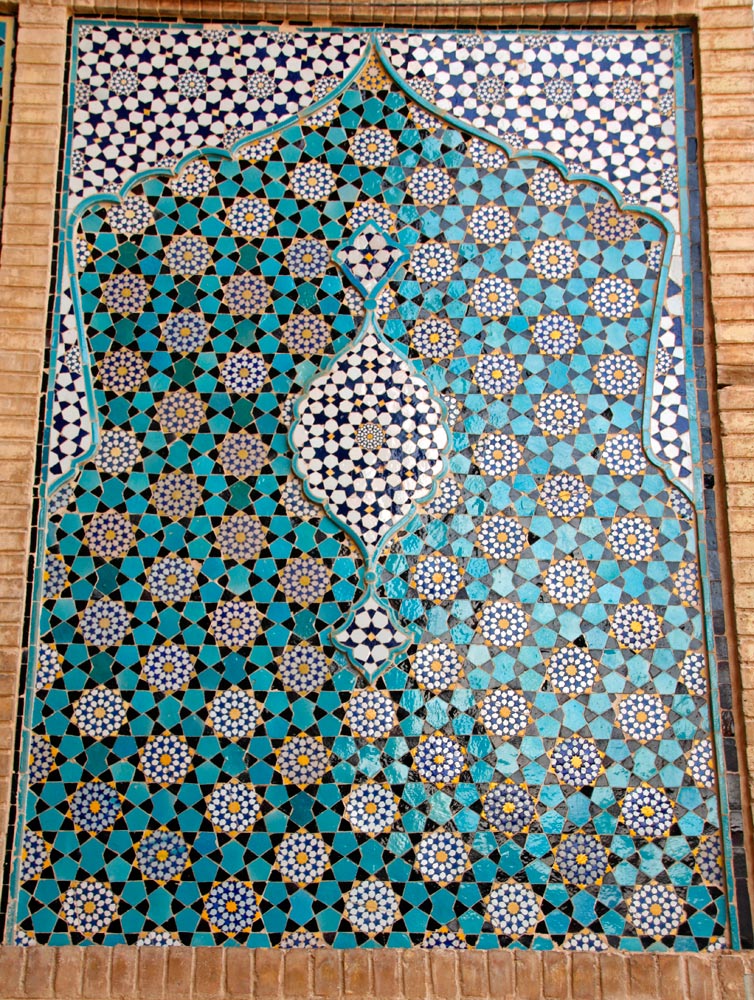

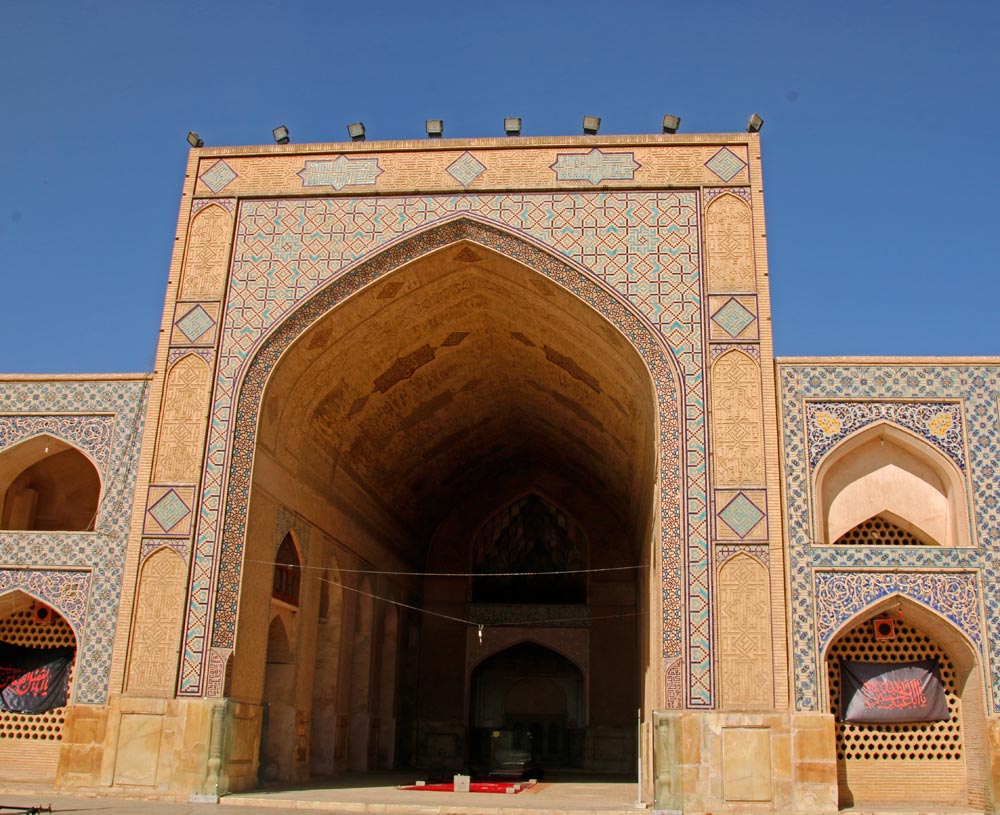
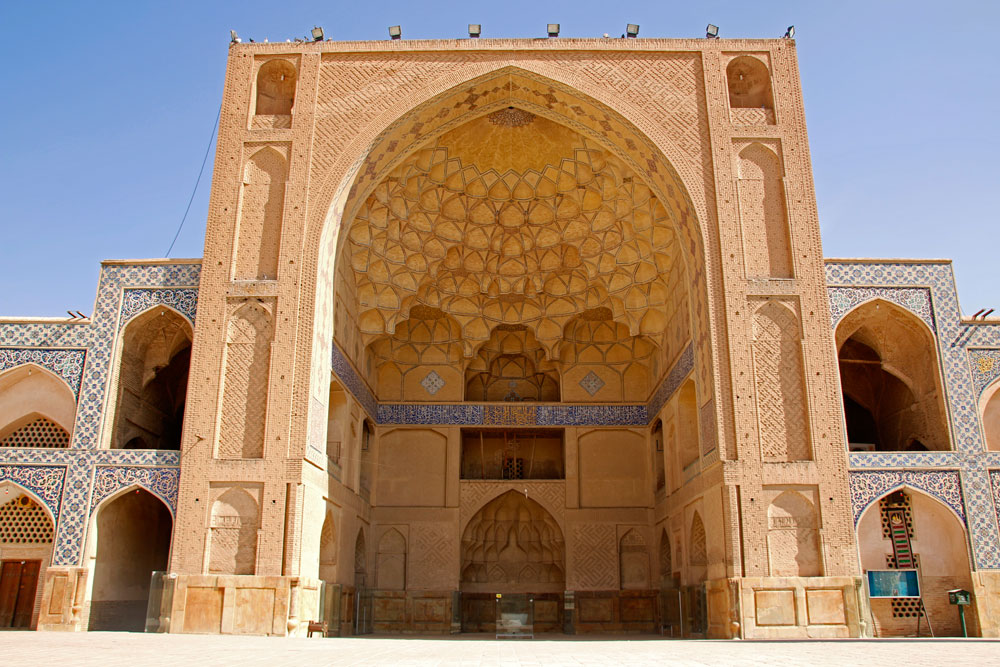
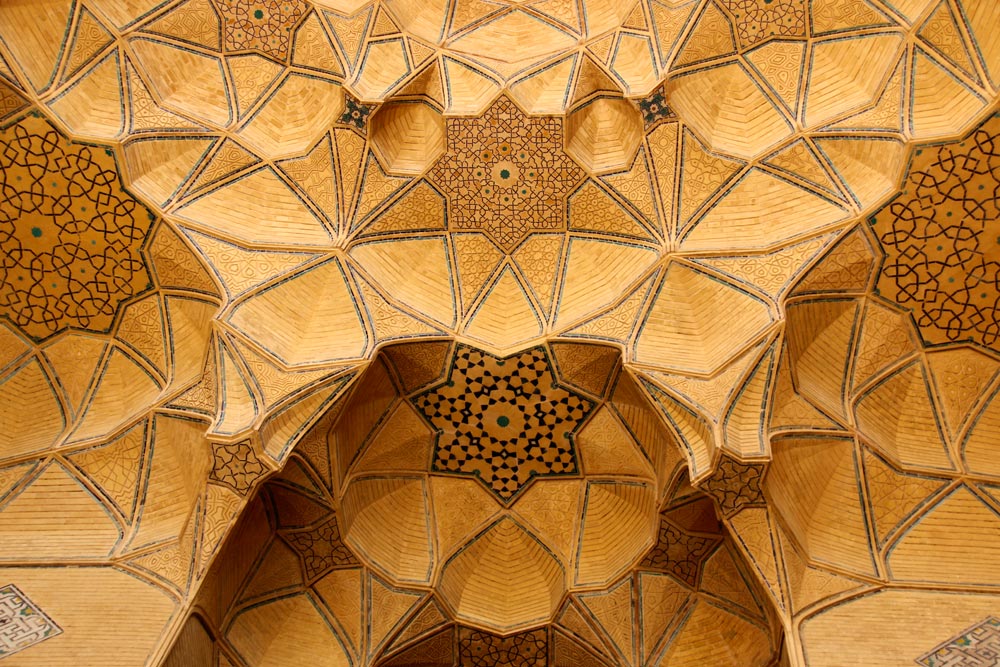
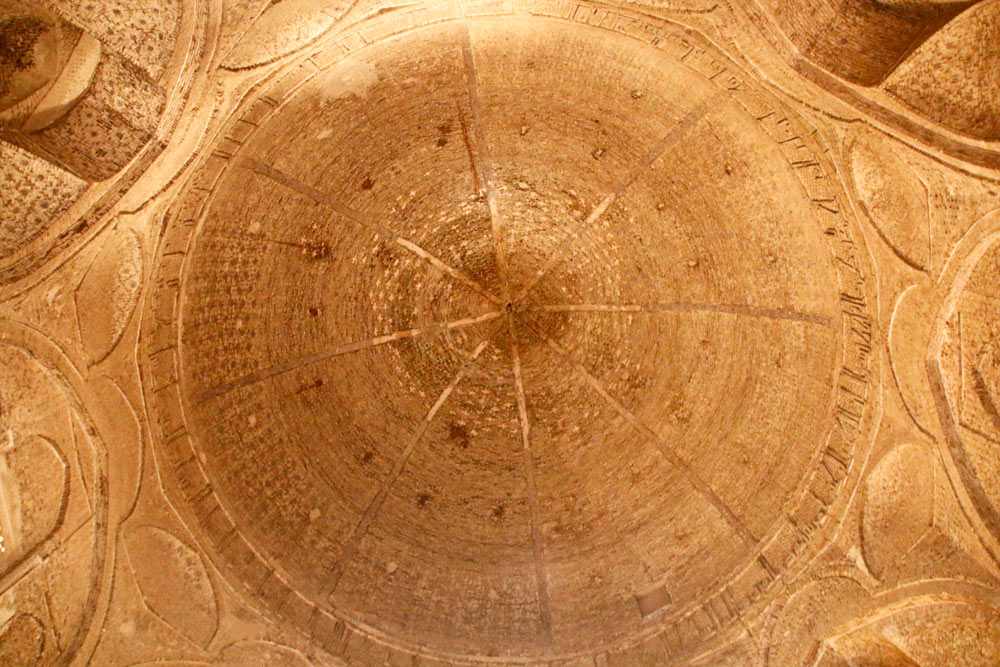

Si-o-se Pol Bridge
The Si-o-se Pol Bridge, also known as the Allah Verdi Khan Bridge, is colloquially known as the 33 Arch Bridge due to its 33 arches. It is 290.4 meters long and 13.5 meters wide and is one of eleven bridges spanning the Zayandeh Rud River. In the hot summer months, this is often dried up or has only little water.
The Si-o-se Pol Bridge is a two-story pedestrian bridge and is completely closed to car traffic. Its pedestrian crossing is framed on both sides by covered arcades.
It is illuminated at night and serves as a meeting place for the residents of Isfahan on warm summer evenings and not so hot days. They meet on both sides of the river bank to talk, eat and drink together and cool off in the river.
Shah Abbas I had the Si-o-se Pol Bridge built in 1602 with the help of his general and benefactor of the bridge, Allahverdi Khan Undiladze. It served to connect the Shah’s four gardens with the royal gardens. The Si-o-se-Pol Bridge was also the model for the Khaju Bridge, which is 48 years younger.
- Address: Enghelab Sq Chahar Bagh e Abbasi Street, JMV8+QX8, Isfahan, Iran.
- Opening Hours: Open 24 hours.
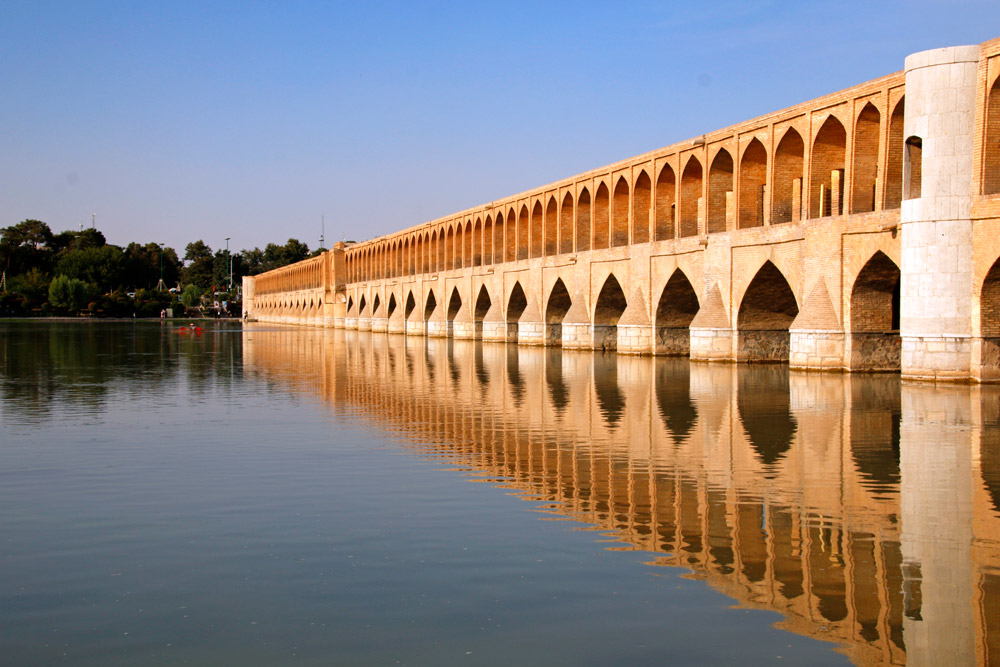
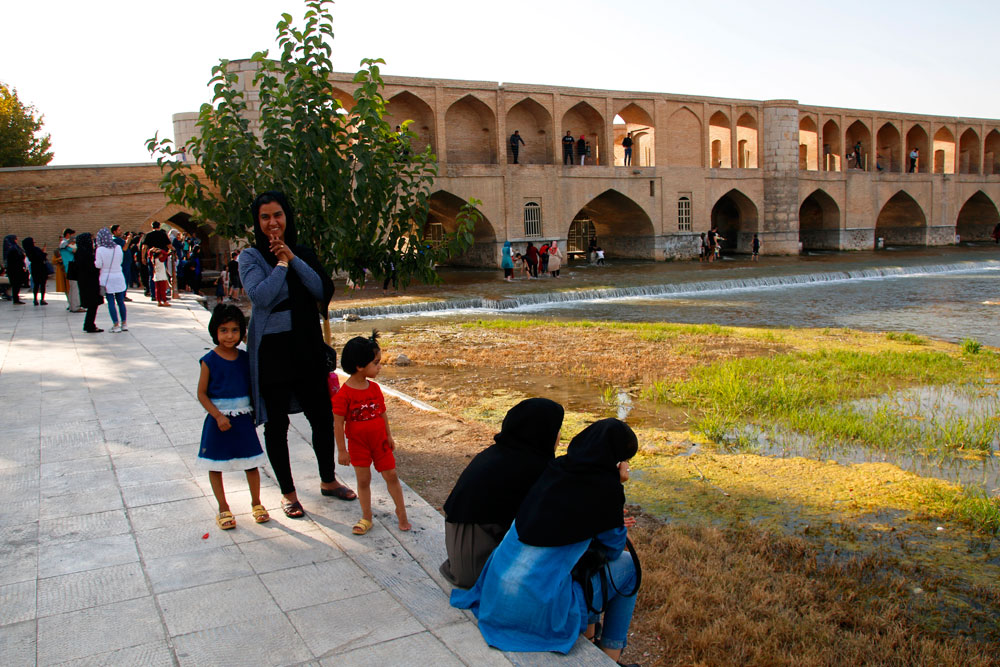



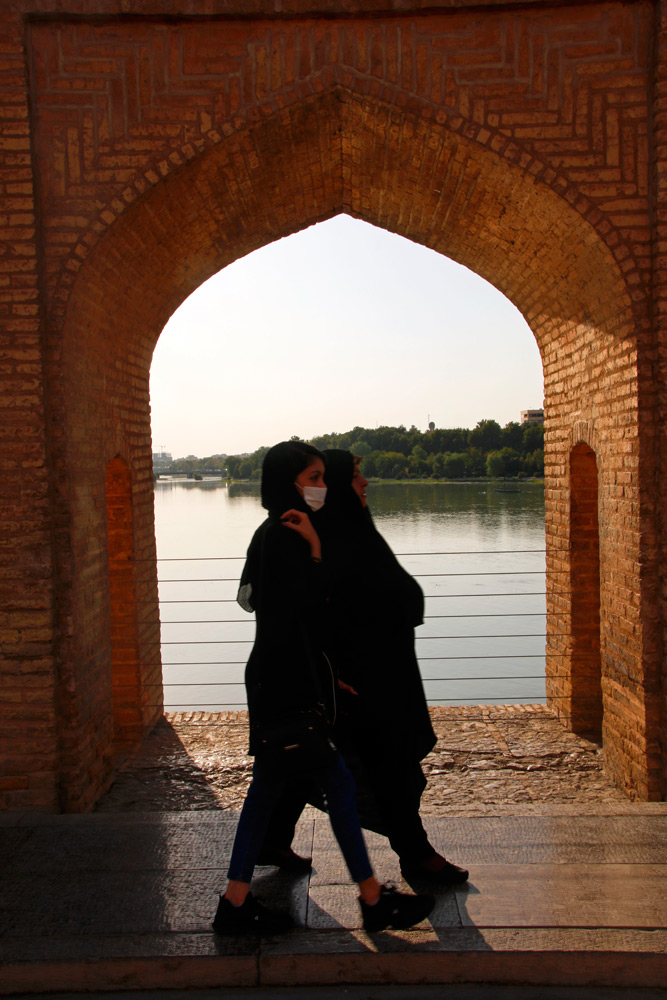

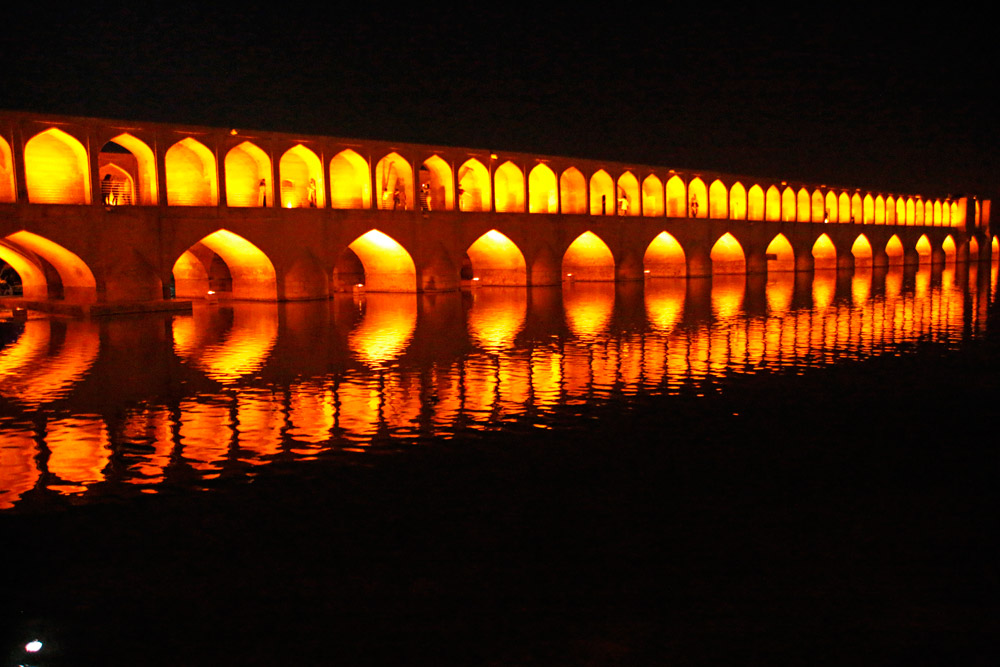
Khaju Bridge
The Khaju Bridge, also called Pol-e Chādschu, is considered the most imposing bridge in Isfahan and, together with the Si-o-se Pol Bridge, is one of the most famous bridges in the city. It is two kilometers east of the Si-o-se Pol Bridge and, like it, spans the Zayandeh Rud River.
The Khaju Bridge has 23 brick arches and is 128.7 meters long and 11.7 meters wide. In its center there is an octagonal palace with several viewing platforms. The Khaju Bridge is also two-tiered and car-free. Its lower section serves as a pedestrian crossing. The steps on the downstream side lead down to the river and are a popular meeting place for Isfahan’s citizens. The floodgates on the arches of the bridge can be closed to ensure that the green areas on the riverbanks are watered even when the water level is low.
Shah Abbas II had the Khaju Bridge built in 1650 and named it after a nearby district. An older bridge from the Timurid period had previously stood here.
- Address: Khaju Bridge, JMPM+P84, Isfahan, Iran.
- Opening Hours: Open 24 hours.

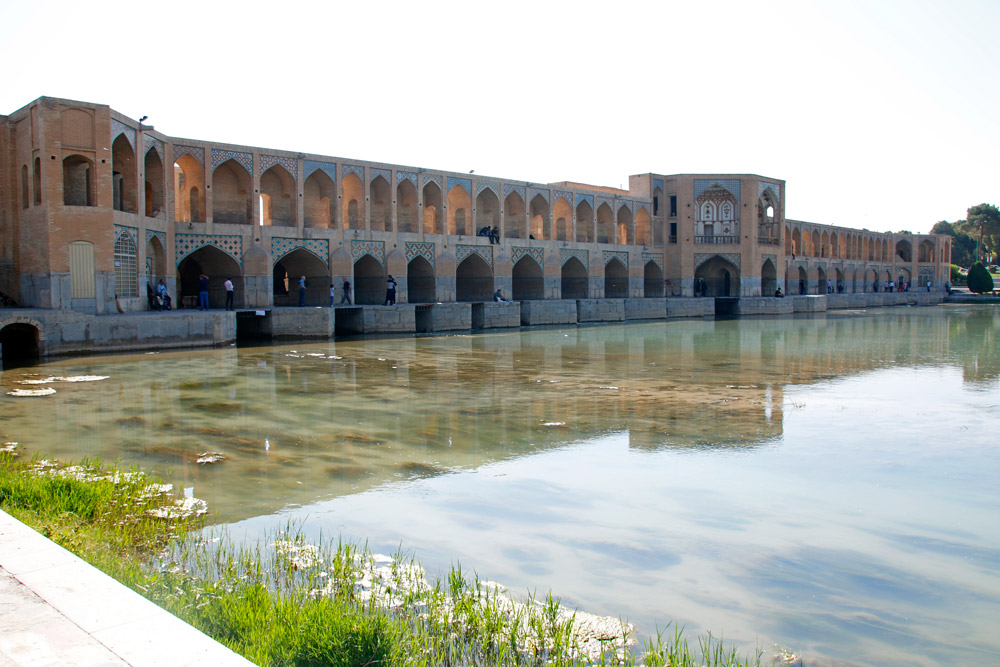
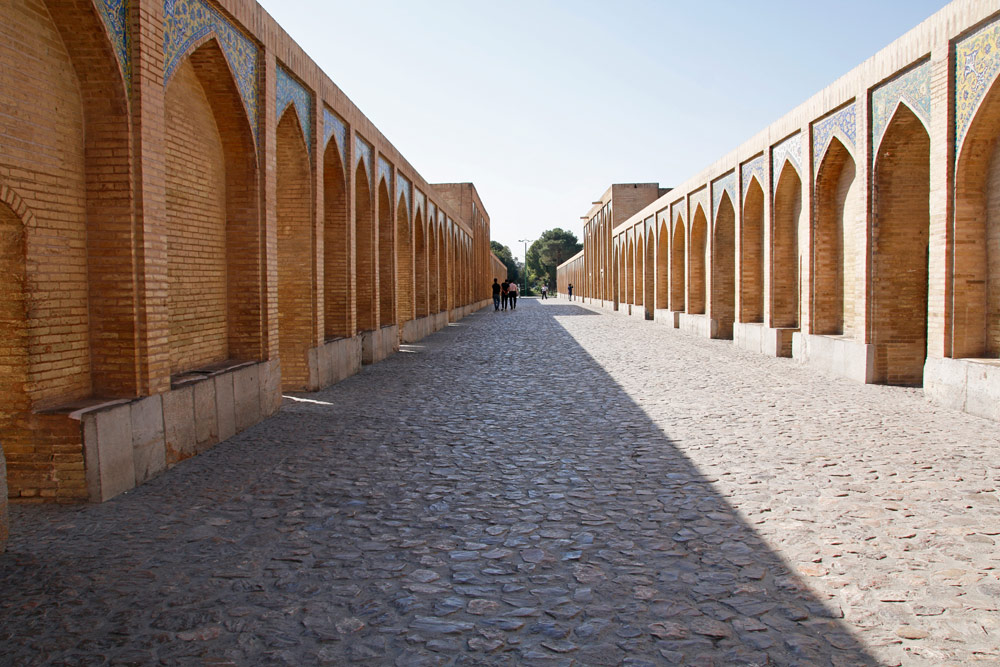

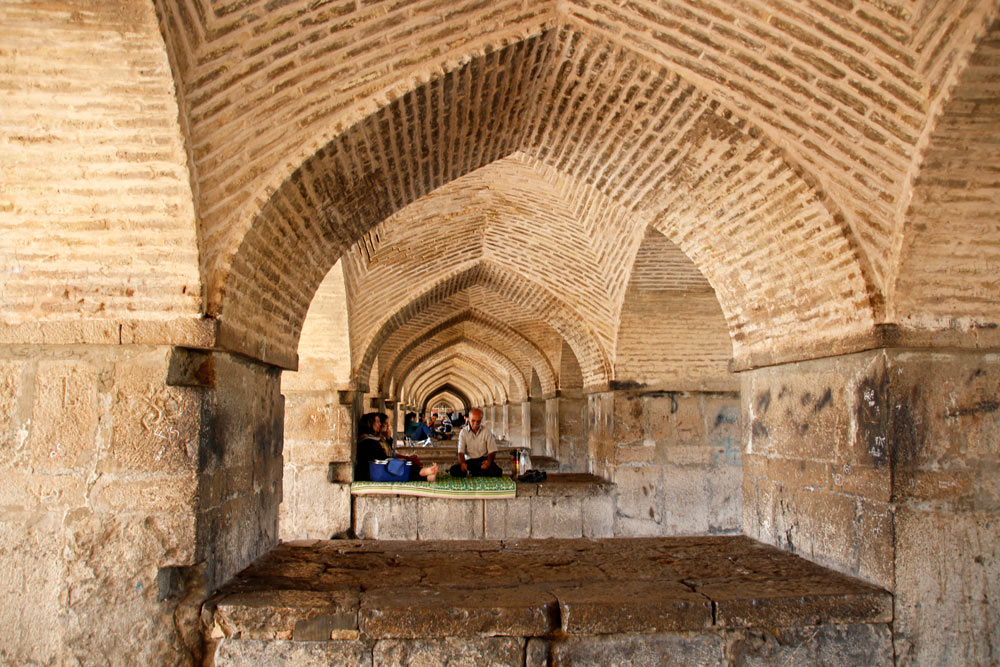
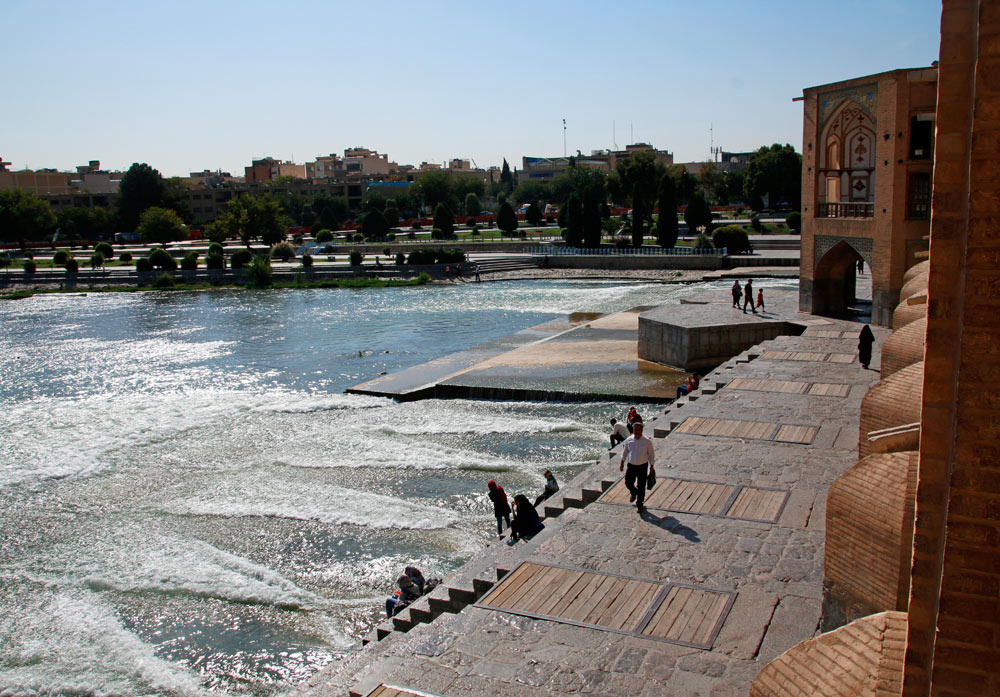
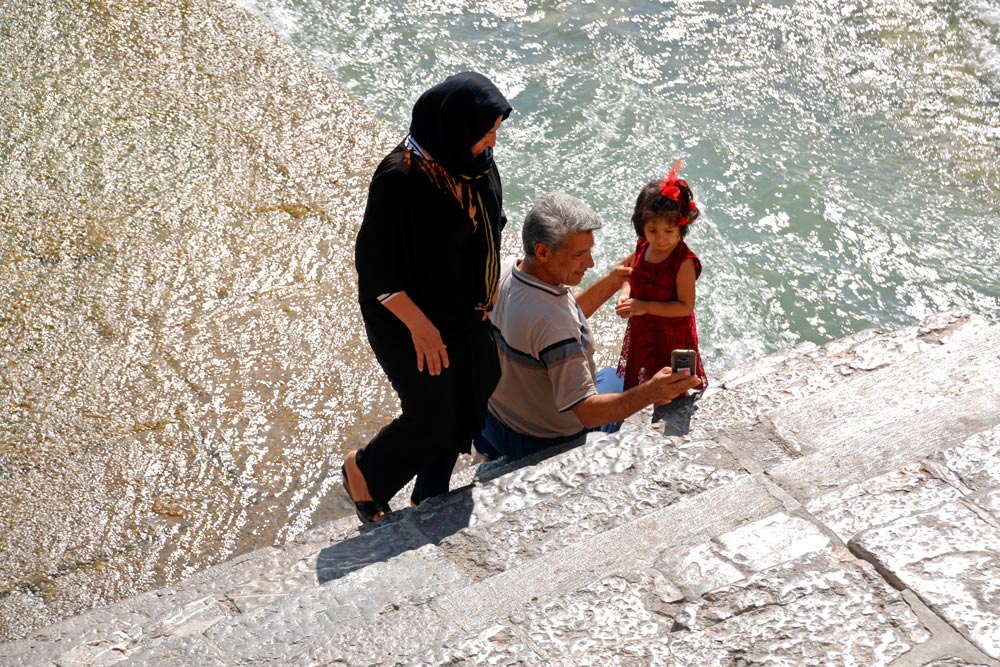
Armenian Quarter Jolfa
The Armenian Quarter, also known as Jolfa, is located on the southern bank of the Zayandeh Rud River. At the beginning of the 17th century, Shah Abbas I resettled 50,000 Armenians here. He named the district Jolfa after an Iranian town on the border with Armenia. He granted the Armenian settlers access to offices in his government apparatus in order to increase his independence from the Persian and Turkic-speaking ruling classes in his own country. He also wanted to improve international trade relations. The Amenians enjoyed freedom of religion and established several Christian Apostolic churches.
The most important place of worship in the Armenian Quarter is the Vank Cathedral. Other churches in the Armenian Quarter include Bethlehem Church (Kelisa-ye Betlehem in Persian), St. Mary’s Church (Kelisa-ye Maryam) and St. George’s Church (Kelisa-ye Gharib). In addition, today the Armenian Quarter has modern boutiques, restaurants and cafes and attracts the local middle and upper classes in addition to foreign visitors.
- Address: South of the Zayandeh Rud River, Isfahan, Iran.
- Opening Hours: Open 24 hours.
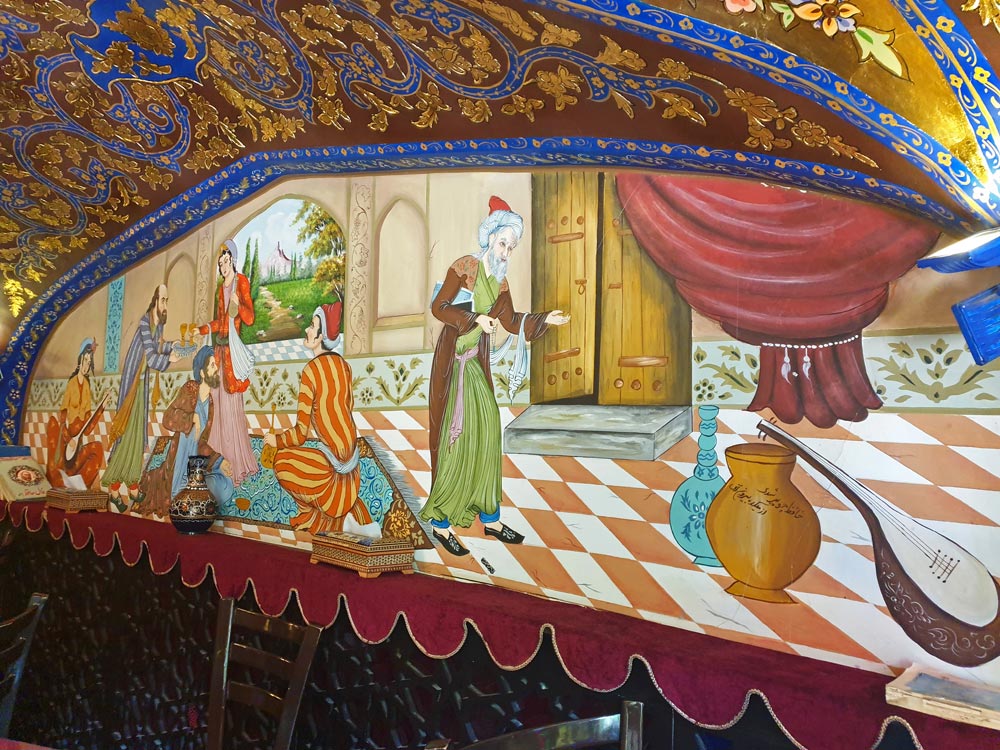


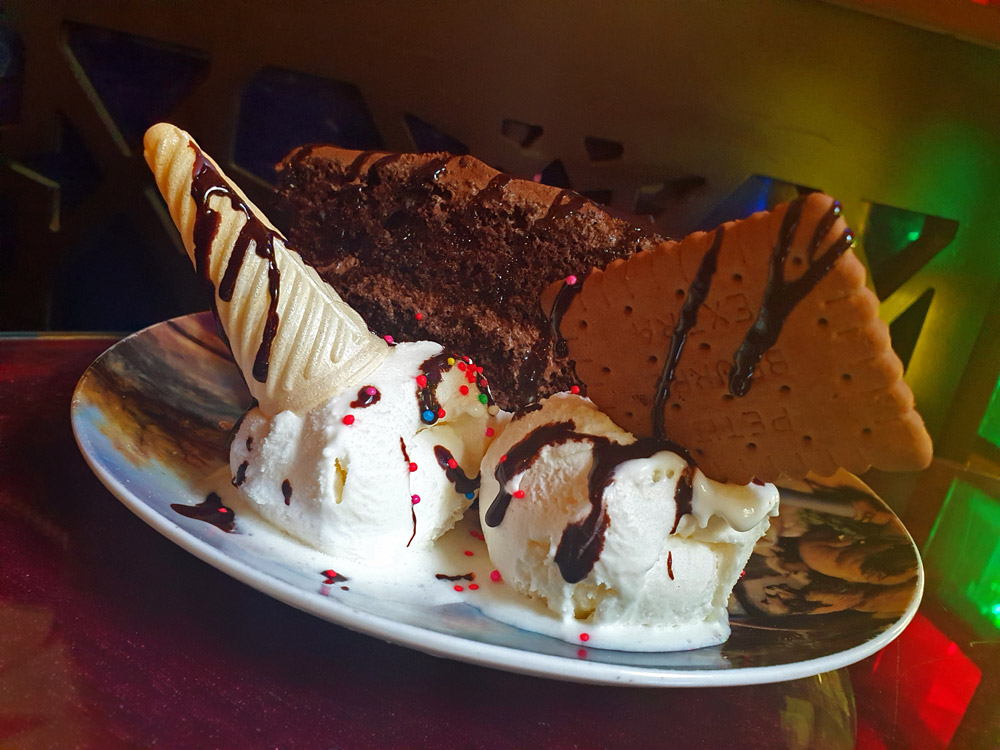
Vank Cathedral
The Vank Cathedral, Kelīsā-ye Vānk in Persian, is an Armenian Apostolic church as well as the largest and most important cathedral in the Armenian district Jolfa. Vank means monastery or convent in Armenian. The Vank Cathedral is also called “Holy Savior Cathedral” or “Church of the Saintly Sisters”. It was created between 1655 and 1664. Its architecture is more reminiscent of an Islamic than a Christian building and combines Persian, Byzantine and Western components. On top of the building there is a large dome like on a mosque and on top of it a cross like on a Christian church. The combination of Islamic and Christian elements give the Vank Cathedral its special appeal.
Inside you will find opulent frescoes and tile decorations. On the walls are numerous paintings depicting scenes from the Old and New Testaments and the history of Armenian Christianity. Otherwise, the interior is decorated in gold and blue tones.
The bell tower stands a little apart from the church building. There are also some Christian tombs on the property. Opposite Vank Cathedral is a museum where you can get an insight into the history of Armenian Christians in Iran and their persecution in Turkey during World War I. Next to the church is a library with several hundred works on the history of Armenians in Iran. A memorial stone on the grounds of the Vank Cathedral also commemorates the genocide of the Armenians in World War I in 1915 and 1916.
- Address: Vank Church Alley, Isfahan, Iran.
- Opening Hours: Monday to Sunday from 8 AM to 1 PM and from 2.30 PM to 5.30 PM.
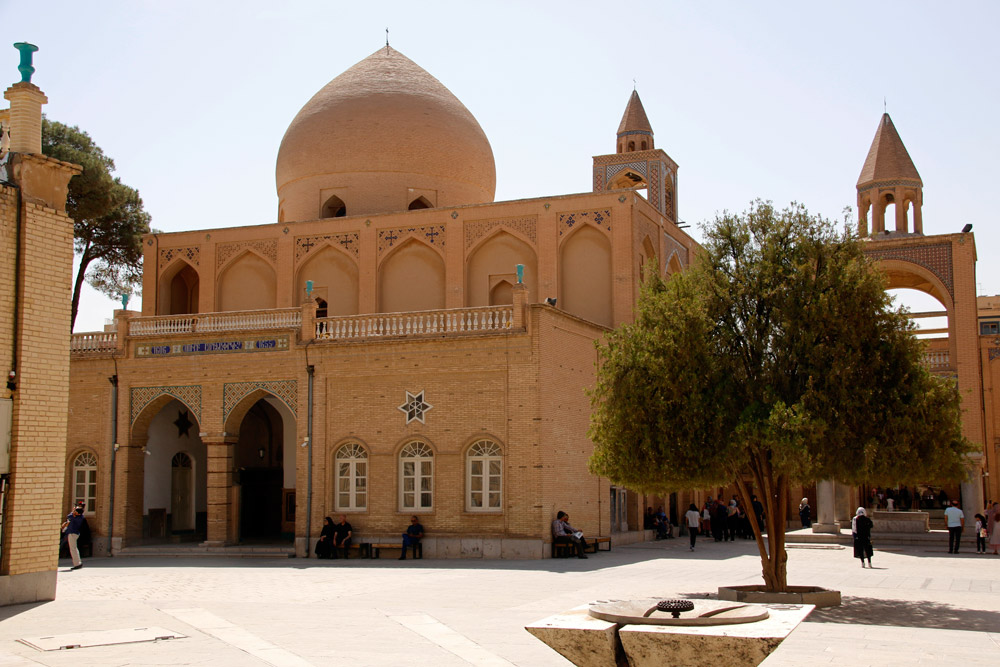
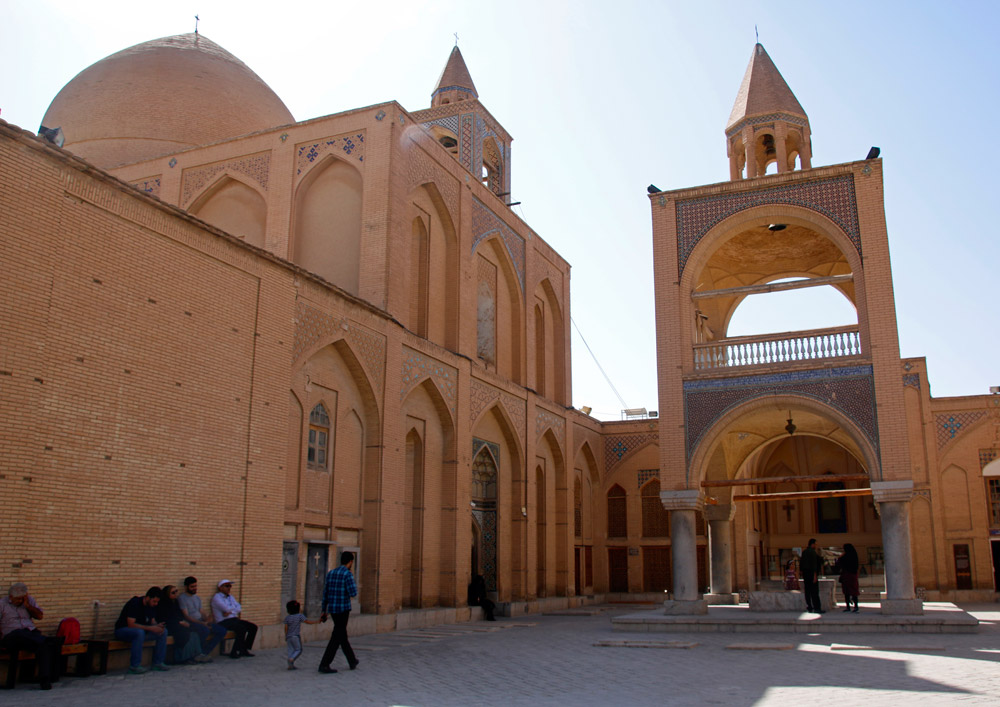
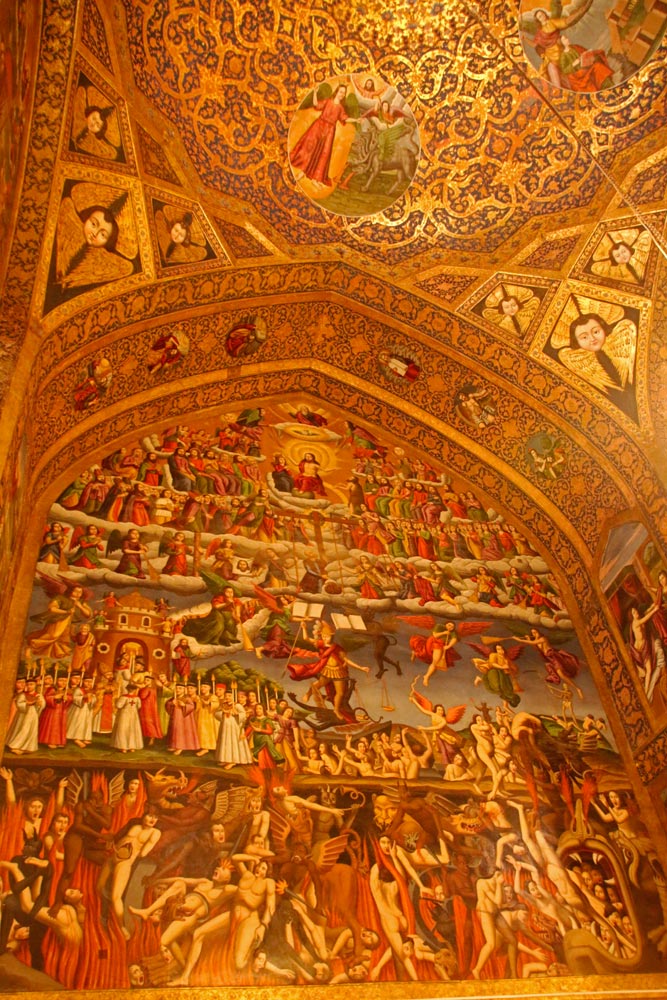
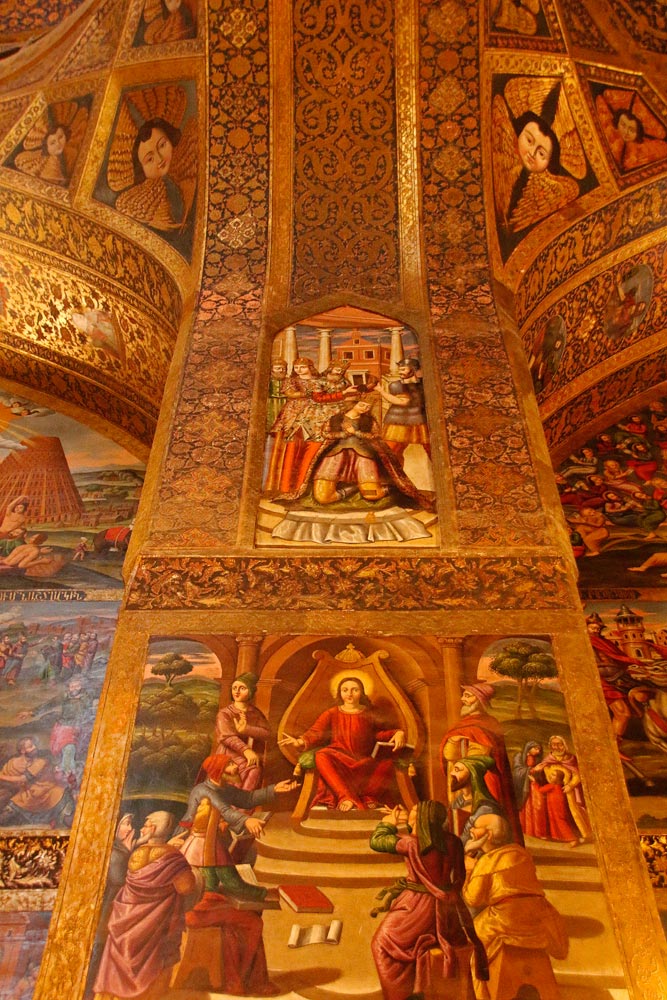
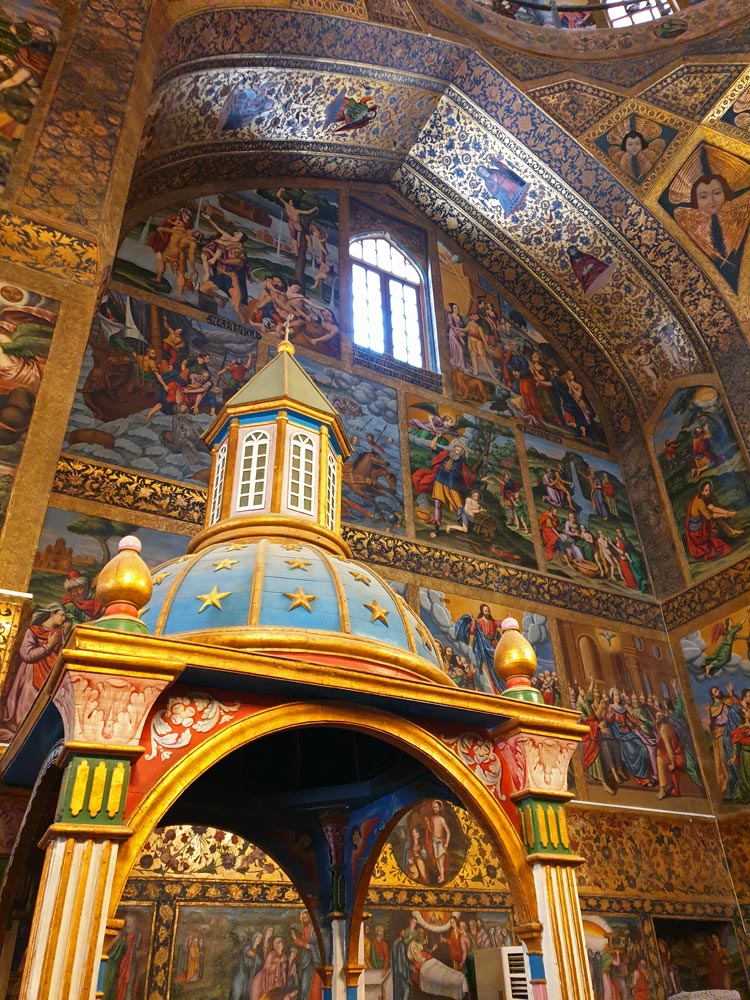
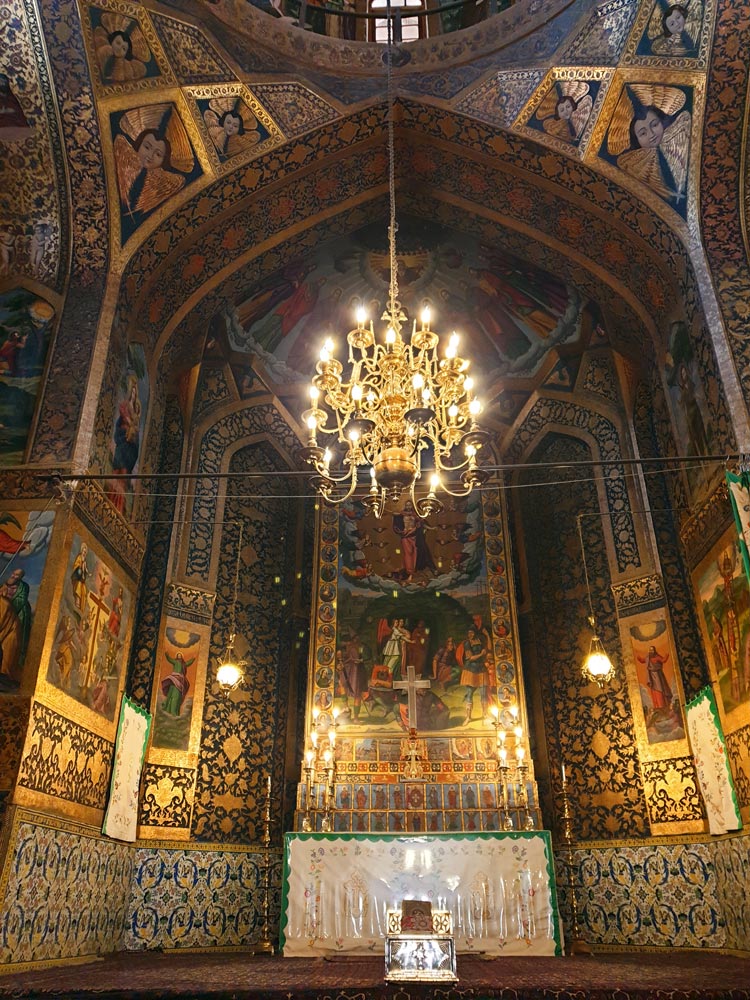
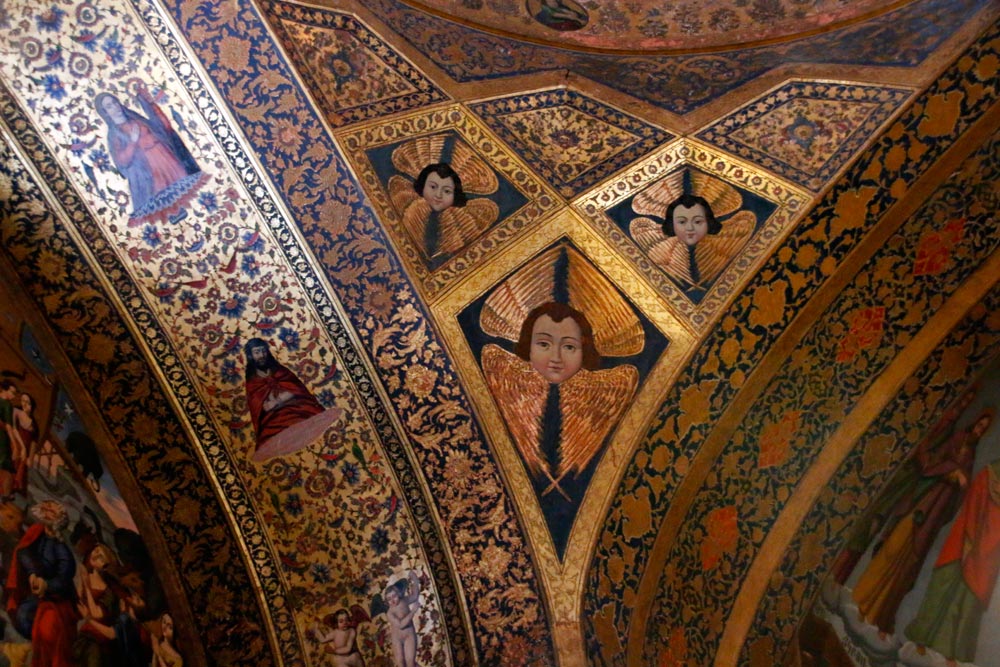
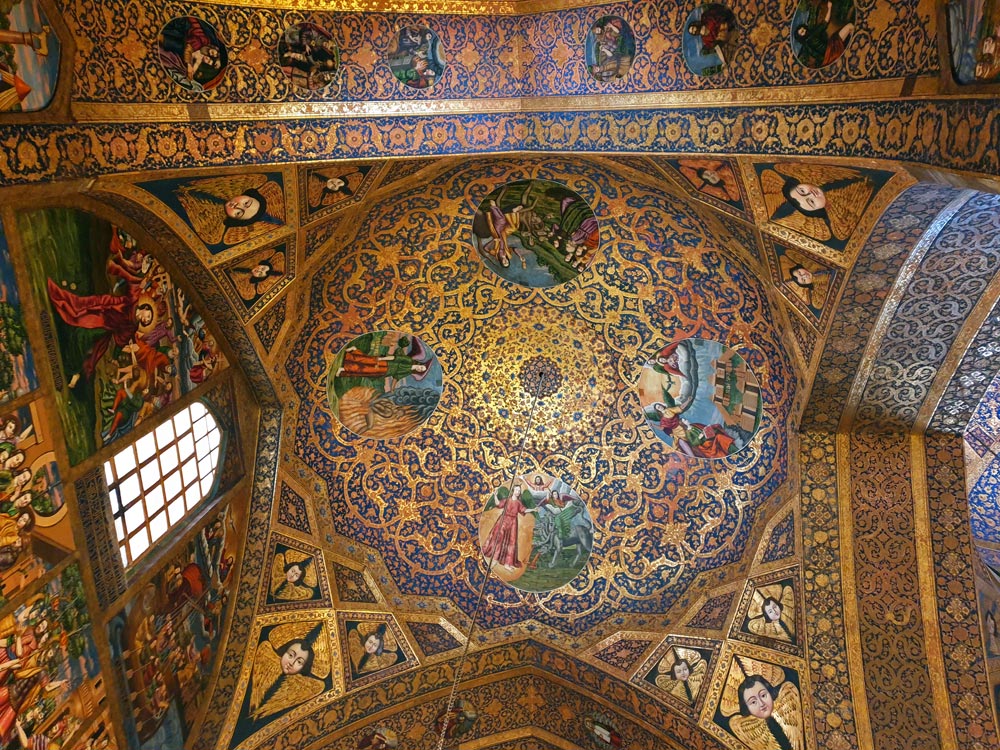
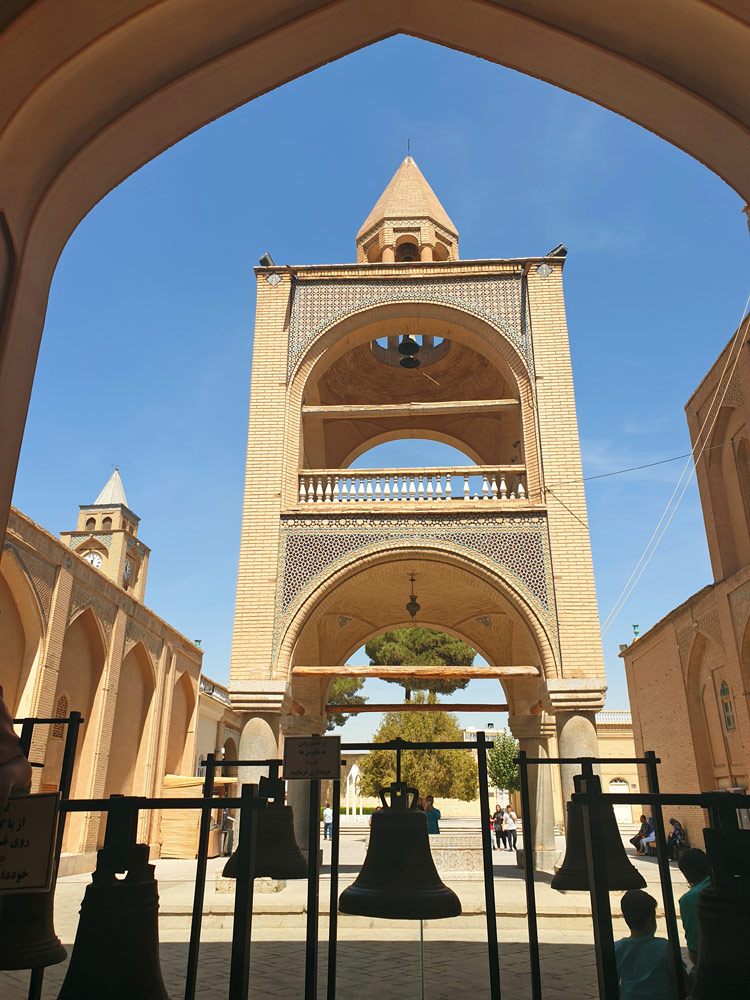
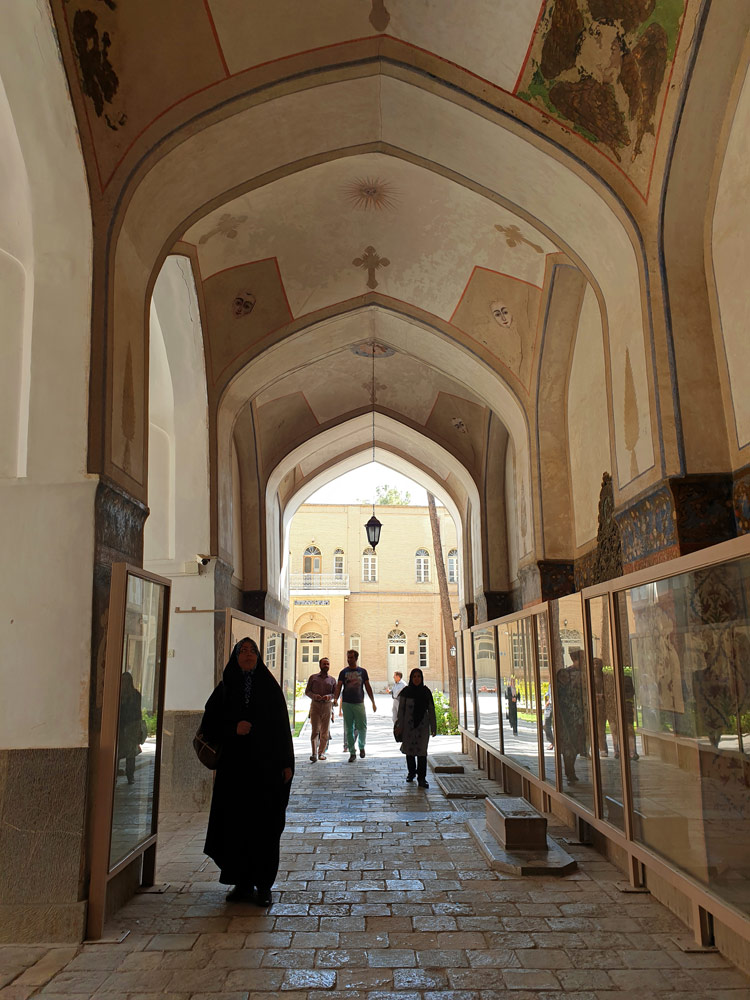
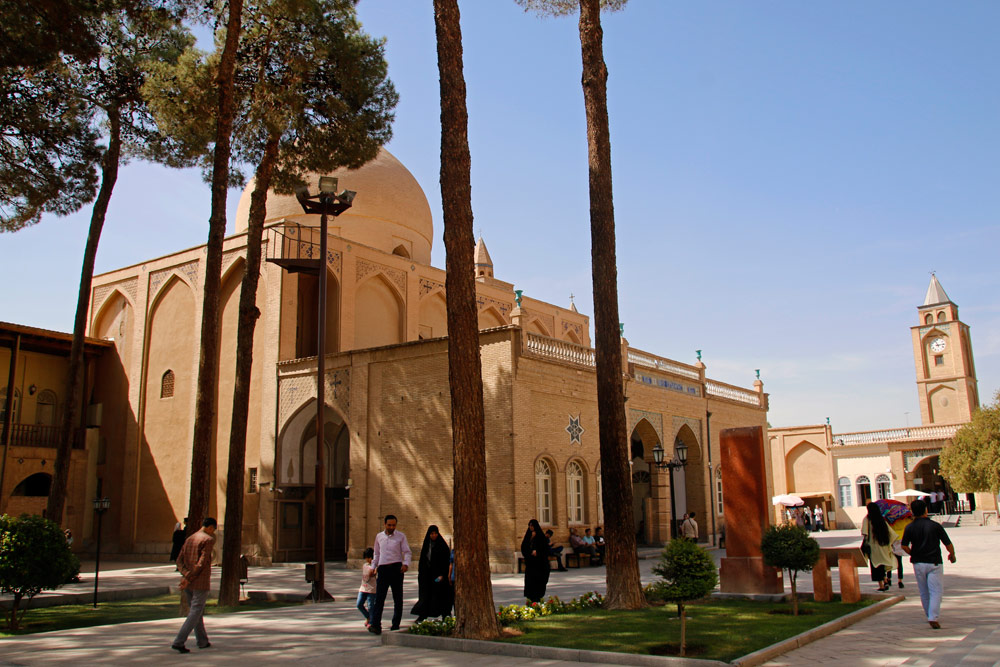
Chehel Sotoun Palace
The Chehel Sotoun Palace stands about 650 meters west of the Ali Qapu Palace in a large green area in the palace district of Daulalatkhana. The actual palace building is located behind an extensive water basin. The covered porch of the Chehel Sotoun Palace is supported by 20 wooden pillars, which are reflected in the water depending on the sunlight, giving the impression that there are forty pillars. That is why the Chehel Sotoun Palace is also known as the Forty Column Palace. The columns are 16 meters high and decorated with intricate carvings. The roof of the porch is decorated with wooden ornaments.
Behind the porch, the enchanting entrance ivan, covered with numerous mirror mosaics, awaits you. The main hall behind it appears to be divided into three parts by the three arches on the ceiling. On both long sides of the building you can see a total of six large murals. Three of them depict famous battles, the other three depict luxurious royal receptions. Below and in the adjoining rooms are smaller pictures showing love and garden scenes. There is also a small museum in the adjoining rooms. Unfortunately, the adjoining rooms and the museum are only occasionally accessible.
The Chehel Sotoun Palace was already planned by Shah Abbas I, but not completed until 1647 by his successor Shah Abbas II.
- Address: Imam Hossein Square, Sepah St., Isfahan Province, Isfahan, Iran.
- Opening Hours: Monday to Sunday from 9.00 AM to 6.30 PM.
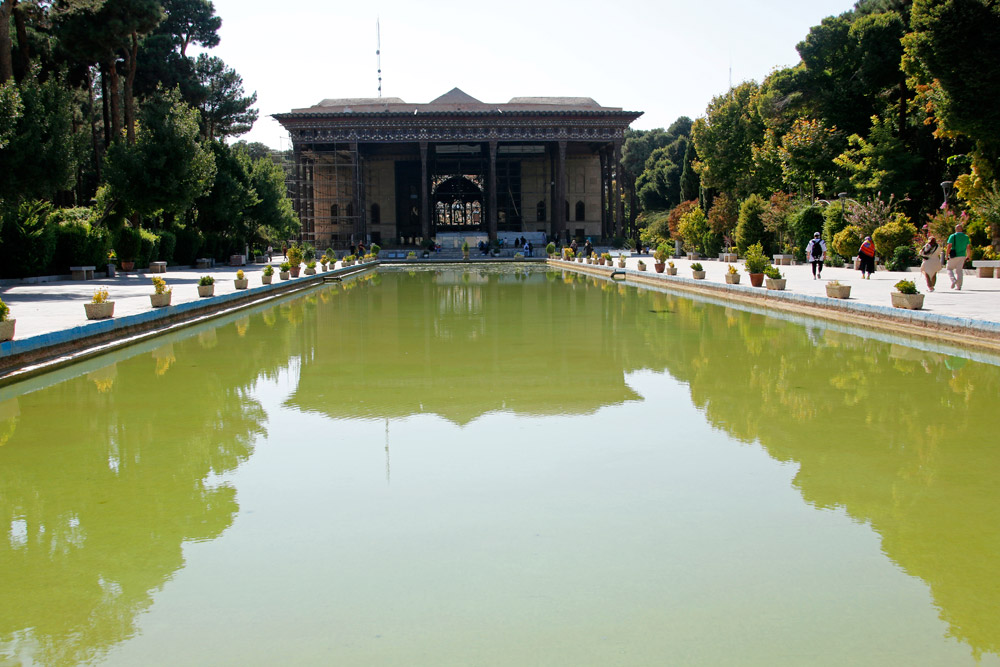
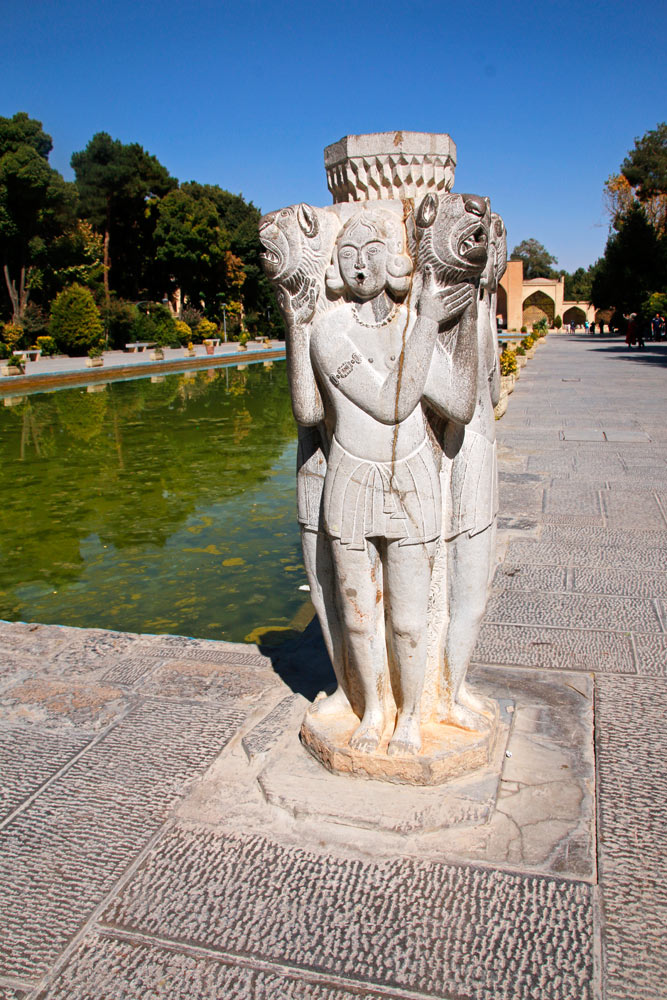

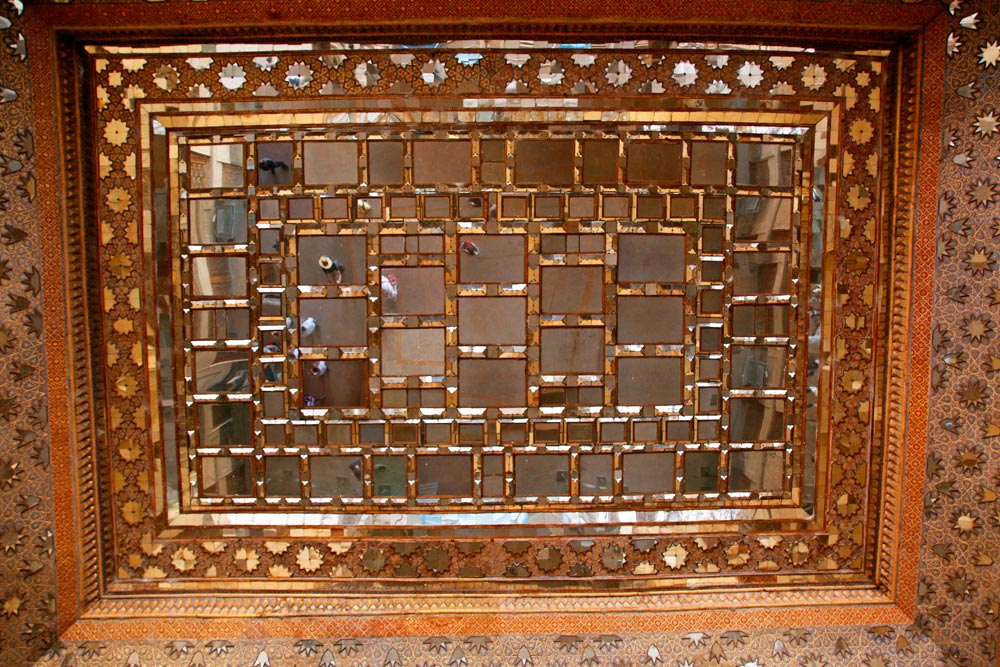
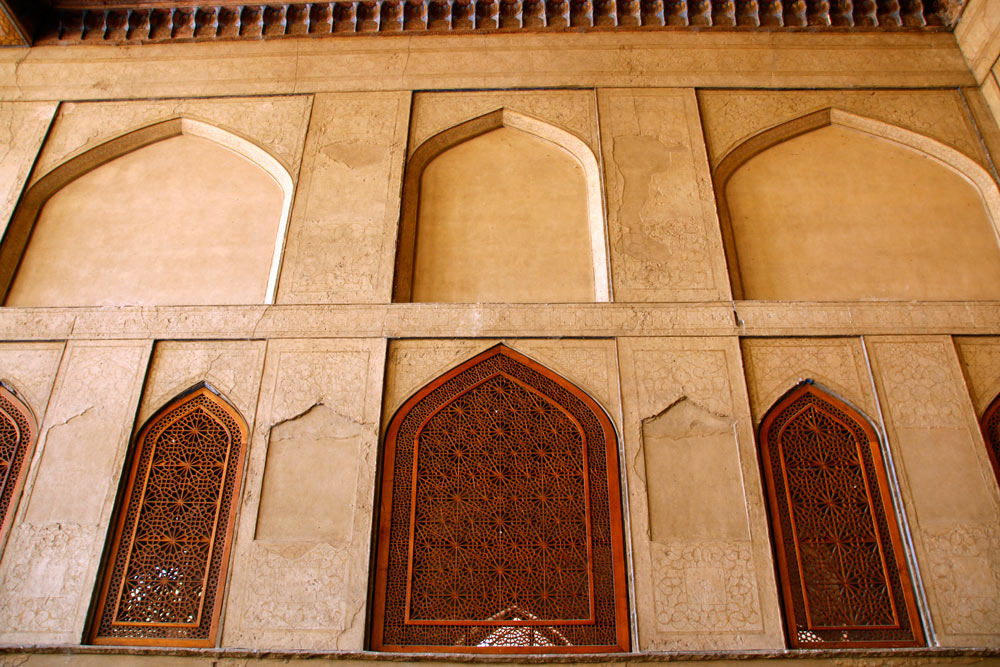



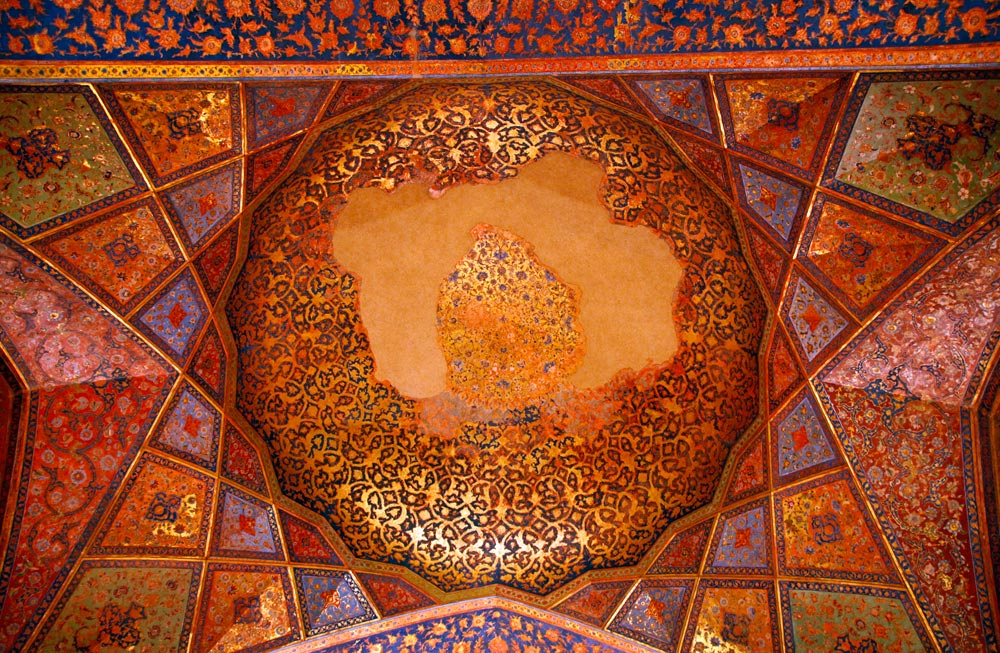
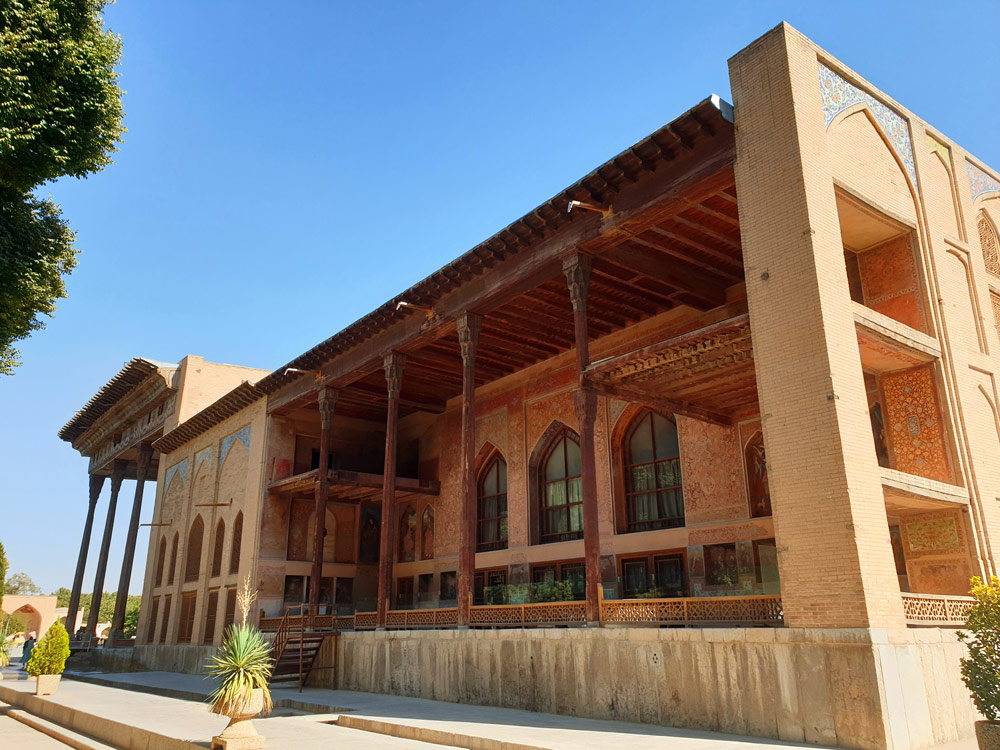
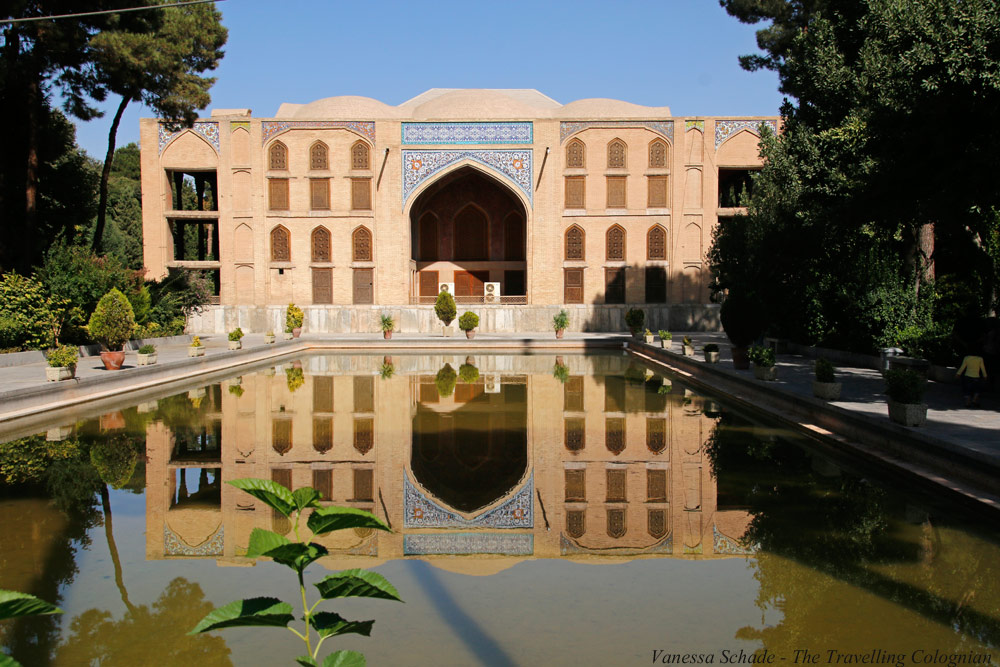
Hasht Behesht Palace
The Hasht Behesht Palace, Kākḫ-e Hašt Behešt in Persian, is located in a Persian garden complex and is about a kilometer and a half from Naqsh-e Jahan Square. The name means Palace of the Eight Paradises. The complex used to be called Bāgh-e Bolbol, which translates to nightingale garden in English.
In the center of the building complex is an octagonal water basin. Four two-story pavilions meet here. Between them stand Ivans facing the garden. The palace impresses with the union of the inner and outer spaces, which extend over two floors.
Hasht Behesht Palace used to be considered one of the most magnificent palaces in Isfahan. Shah Soleiman had it built in 1669. However, over time, the interior design was badly damaged. In 1977 the complex was partially restored. The fresco decorations and the decorated tiles with depictions of birds, beasts of prey and reptiles are particularly worth seeing. The gardens of the Hasht Behesht Palace are now a public park called Park-e Rajayi, in Persian Pārk-e Šahīd Raǧā’ī.
- Address: Chahar Bagh e Abbasi St, MM3C+933, Isfahan, Iran.
- Opening Hours: Monday to Sunday from 9.00 AM to 5.30 PM.
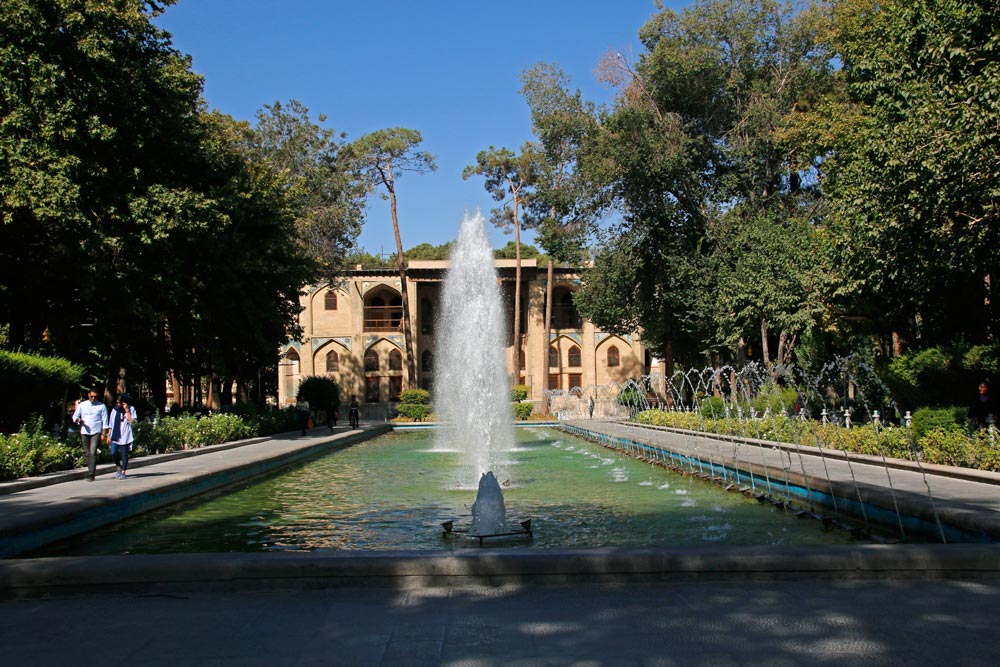
Music Museum
The Music Museum in Isfahan originated from a private initiative. Here you can see more than 300 Iranian musical instruments. The English-speaking tour with the founders and operators of the museum, Mehrdad and Shahriar, is also worthwhile. Afterwards, a concert on original instruments awaits you, which is included in the entrance fee.
- Address: Hasht Behesht Complex, Chahar Bagh e Abbasi St, Isfahan, Iran.
- Opening Hours: Monday to Sunday from 9.00 AM to 9.00 PM.
Isfahan Arrival – How to get there
You can travel to Isfahan by plane, train, long-distance bus or taxi.
How to get to Isfahan by plane
Isfahan Shahid Beheshti International Airport (IATA code: IFN) is located about 20 kilometers northeast of the city. There are international flights to Isfahan from Dubai, Doha, Istanbul and Kuwait, among others. Also within Iran you can e.g. B. get to Isfahan from Tehran, Shiraz, Mashhad and Tabriz, but also from lesser-known cities, by plane.
You can get from the airport to Isfahan city either by taxi or by airport bus that goes to Enghelab-e Eslami Square.
How to get to Isfahan by train
You can also travel to Isfahan from various cities in Iran by train. From Tehran, the journey to Isfahan by train takes just under six hours and from Kashan it takes just under two hours and forty minutes. It is also possible to travel by train from other cities, but sometimes you have to combine a train ride with a taxi ride.
How to get to Isfahan by long-distance bus
It is also possible to travel to Isfahan by long-distance bus. It takes a little over six hours to travel from Tehran to Isfahan by long-distance bus. You can also travel to Isfahan from other cities by long-distance bus.
How to get to Isfahan by taxi
You can also take a taxi to Isfahan. It’s a lot cheaper than you might think. Not only do you get comfortably from one place to another, you also support the Iranian taxi drivers at the same time. Of course, the price and duration of the taxi ride also depend on the distance.
My parents took a taxi from Shiraz to Isfahan in March 2019 and paid 50 euros plus tip for the 480-kilometer journey. The drive took about six hours, but snow was blowing on the way. In normal traffic conditions, the journey takes about five hours.
My opinion on the sights of and best things to do in Isfahan, Iran
I visited Isfahan in September 2019 as part of a tour of Iran and spent three days there. Isfahan and its breathtaking sights and things to do absolutely fascinated me. While I was blown away by all the places I visited in Iran, I was particularly fascinated by Isfahan. There is something magical about the fabulous Naqsh-e Jahan Square with its unique atmosphere, the fairytale mosques, palaces, arcades and the Grand Bazaar, the picturesque bridges and the breathtakingly beautiful Vank Cathedral. I was particularly enthusiastic about the encounters with the people.
Now is definitely not the right time to travel to Isfahan or Iran in general. My thoughts at this time are with my amazing Iranian guide and his lovely wife and their families, with our amazing Iranian bus driver and his family, and with all the wonderful women, girls, boys and men I met on this trip.
I’ve thought long and hard about publishing this article at all at this time, but I had been working on it for a long time. In addition, perhaps now is the right time to pay even more attention to the fabulous city of Isfahan and its sights, the beautiful country of Iran and the incredibly warm, hospitable and open-minded Iranians. That’s what I want to do with this article.
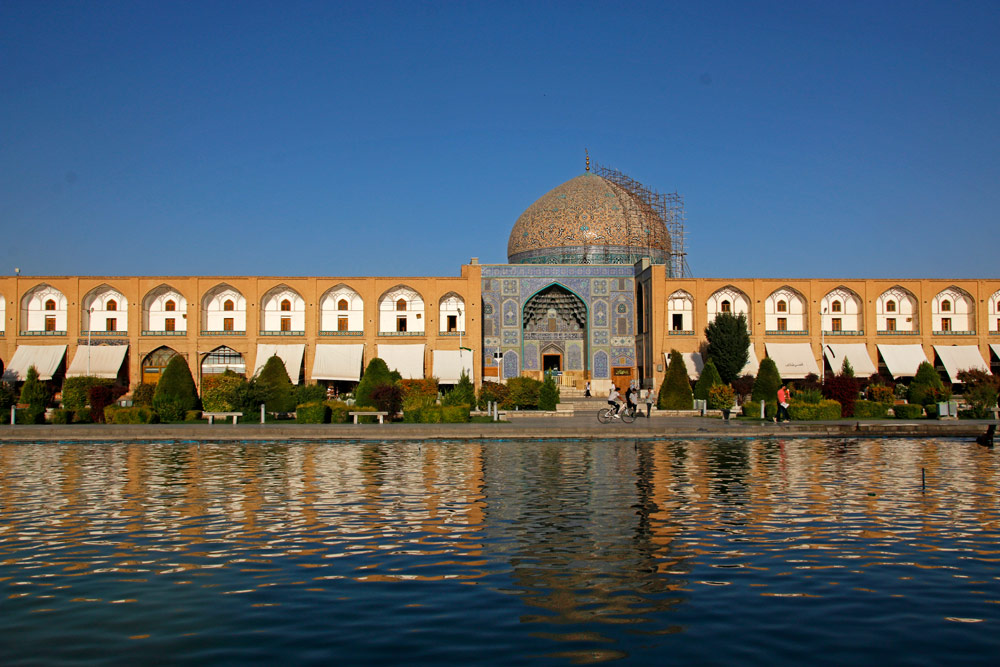
Follow me on Social Media
If you like this blog article and my travel blog, follow me on Facebook, Twitter, and Instagram and share this blog post on Social Media. I would also be very happy if you leave me a comment.
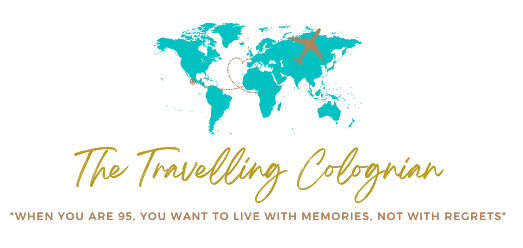
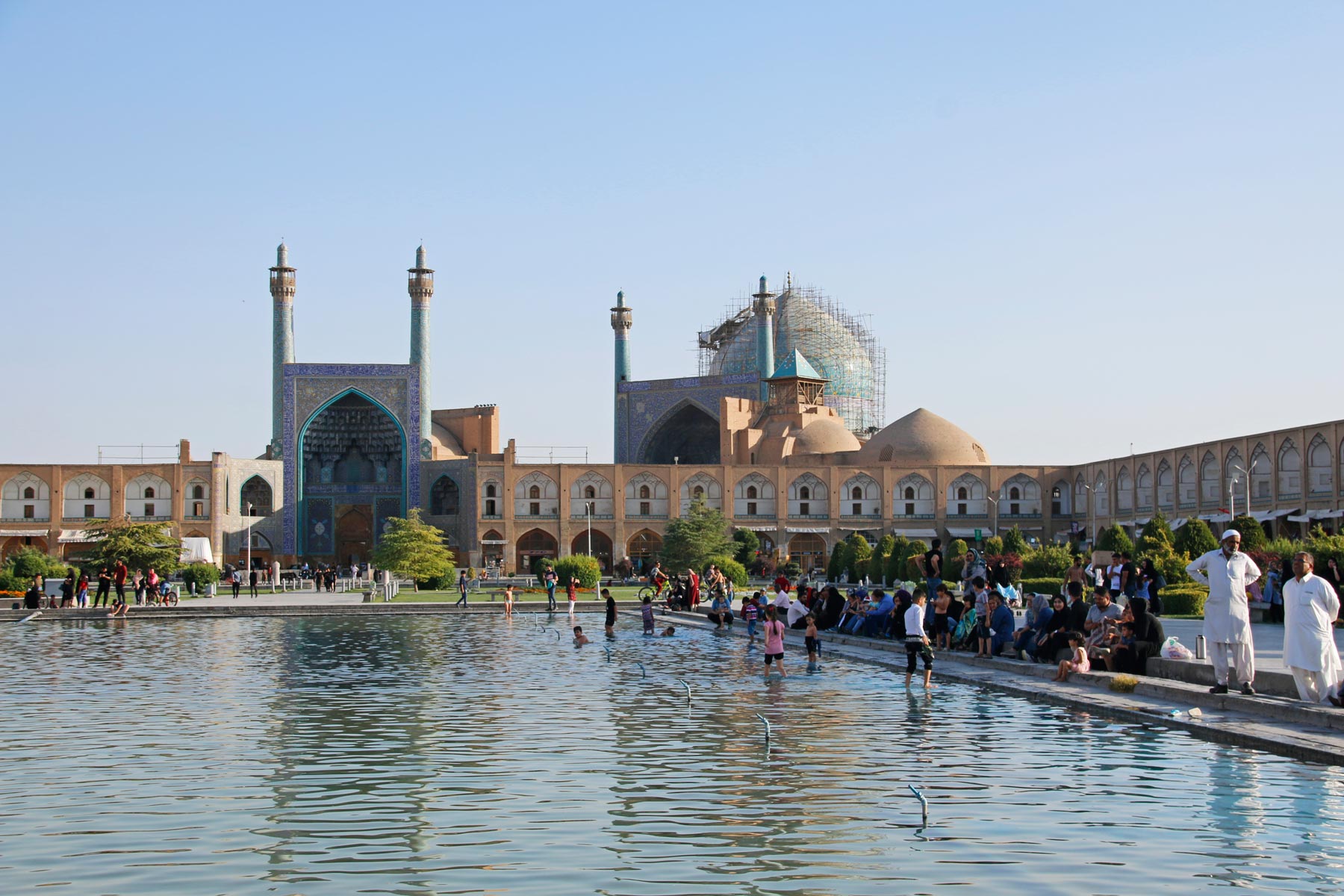
A very interesting report with great photos. It shows what an invaluable culture there is and how amiable the people of Isfahan are. Thank you very much for that.
Isfahan is one of those famously beautiful places I really hope I’ll get the chance to see one day. It’s great that you went before the pandemic and before things began to turn a little shaky in the country.
Such a flood of images – completely impressive – if touches me deeply!
Thanks for that
This is a highly impressive documentation of an unusually rich city. Well done!
Bernd